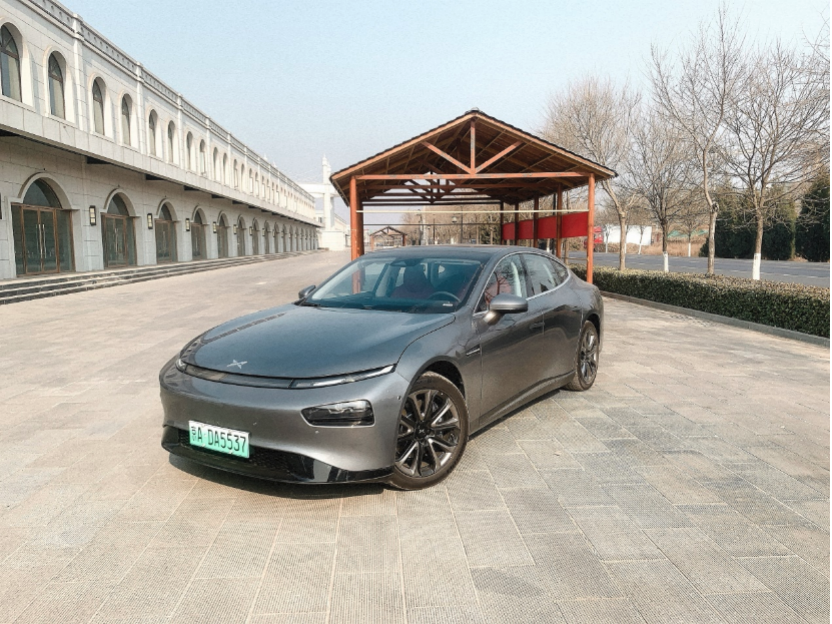Let’s start with some high-quality pictures first:

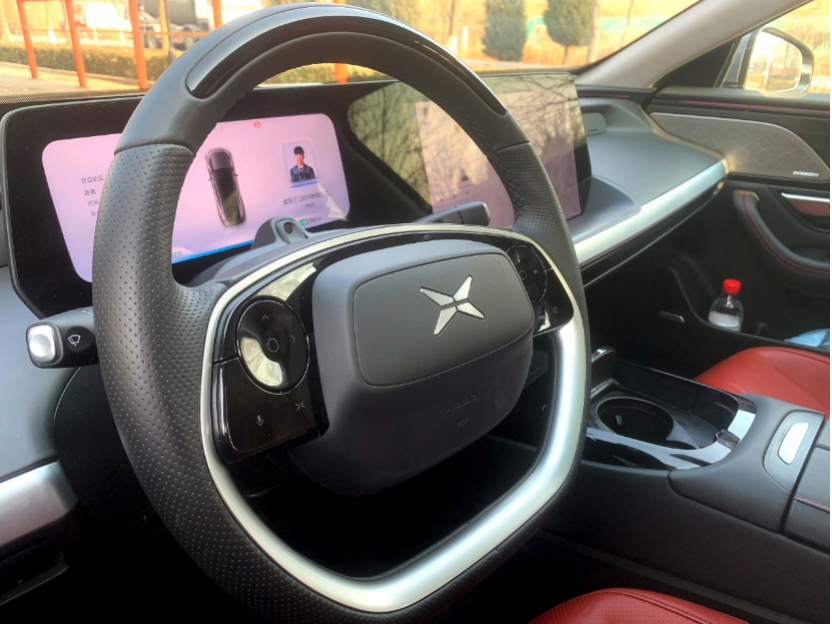
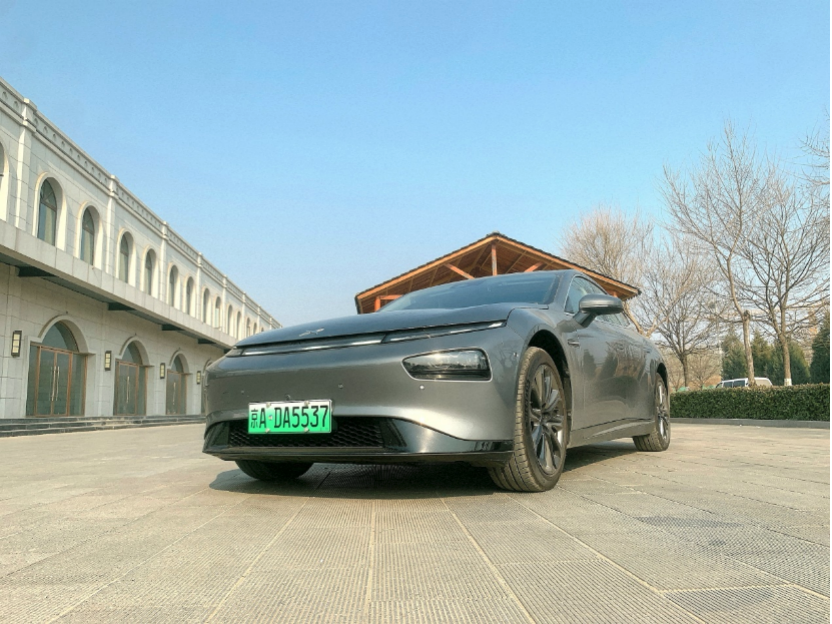
At home, I have two cars: one is a imported 2013 Audi Q3 and the other is a 2018 2.0 Mazda Axela hatchback. The Q3, with its authentic German EA888 engine, has a constant supply of Jia Shi Duo in its trunk after 40k km. It’s getting old, so I’ve put changing cars on my schedule.
Needs Assessment
Although both cars in my household use gasoline, my priority for this change is to switch to new energies. This decision is based on my specific driving patterns: mostly commuting within the city, and occasionally going on short trips nearby. New energy vehicles have lower running costs, faster acceleration, and are easier to maintain, making them perfectly suited for my driving needs. The only problem is that, at the moment, recharging stations are not available in my old residential area. However, considering that my commuting distance is not too long, I feel that charging once a week is still manageable.
My budget is under 400k RMB and I plan to change cars within the year. I am mainly considering the Tesla Model 3, Model Y, and ES6, and after test driving these three cars briefly in a dealership, I feel that I lean more towards the ES6 because it feels more like a gas-powered vehicle. I received the opportunity to experience the small Xpeng P7 electric car because my friend is working on a startup project where they test drive electric cars, and I was invited to participate in the trial as a seed user experience, using the car for two days. To be honest, I didn’t have much knowledge or information about the P7 before, I only saw it once while shopping in Hesheng mall. My wife thought it looked cool, but the name made me skeptical. However, after two days of test driving, I have a lot of pleasant surprises to share with everyone.
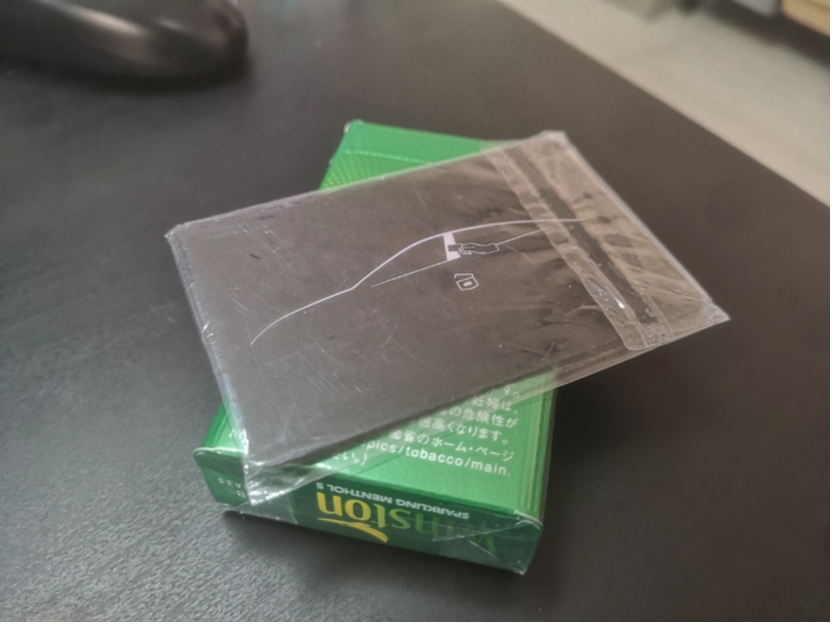
Received the Car
The process of receiving the car was very simple, similar to renting a car. I took some pictures, signed the agreement, paid the deposit, and then I could drive the car. The entire process took less than ten minutes. In addition, there was a card-like device that can open the car door by sensing it on B pillar.
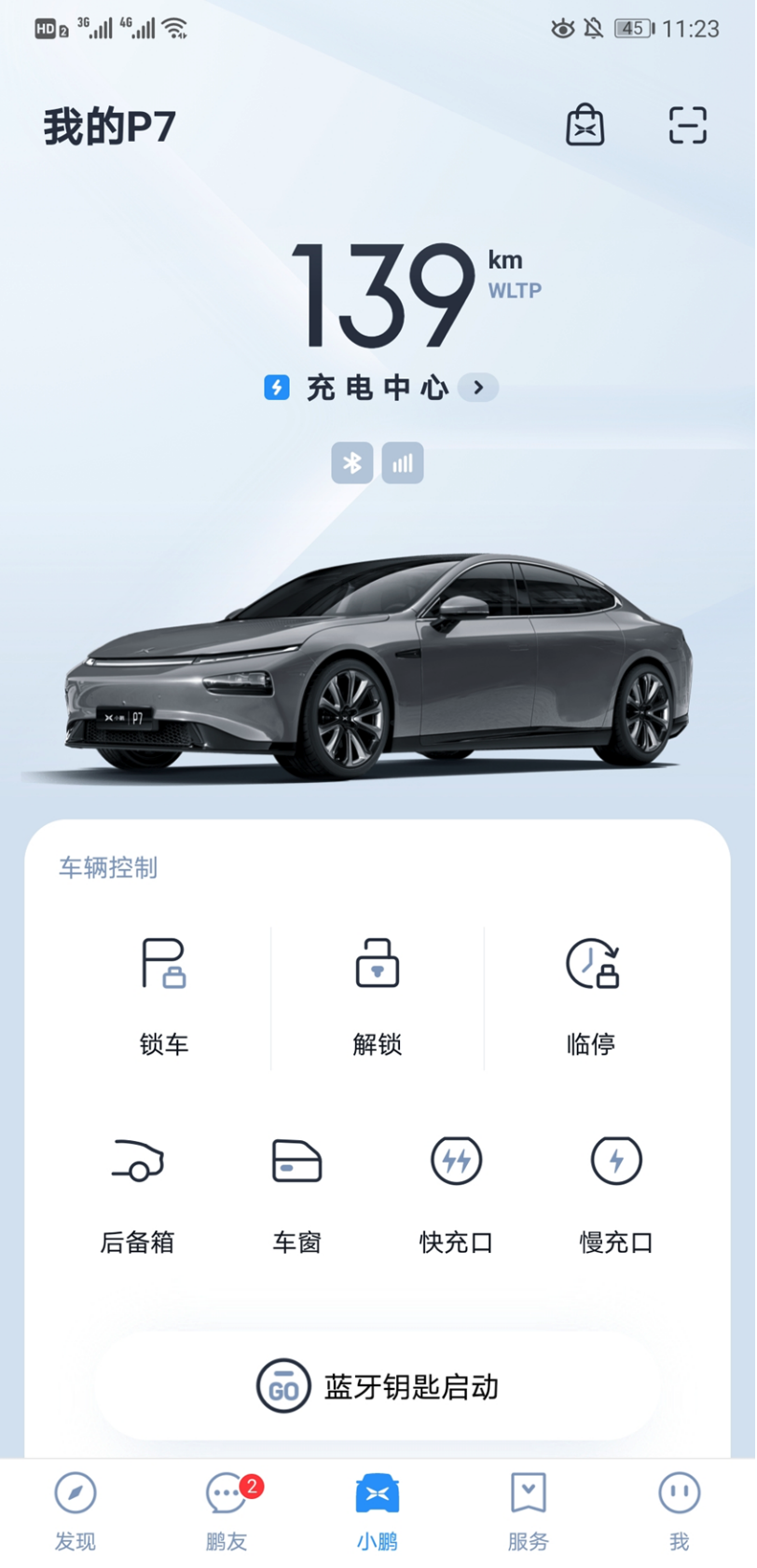
This is the 2020 model year rear-wheel-drive P7 with a long range and intelligent configuration. Its suggested retail price is approximately 266,900 RMB, and its range according to the Ministry of Industry and Information Technology is 670km. The first thing I did when I got the car was to check the battery level. I felt relieved after seeing that it was fully charged. The P7 can display battery levels in two ways: NEDC and WLTP, and I think that the latter is more suitable for everyday use.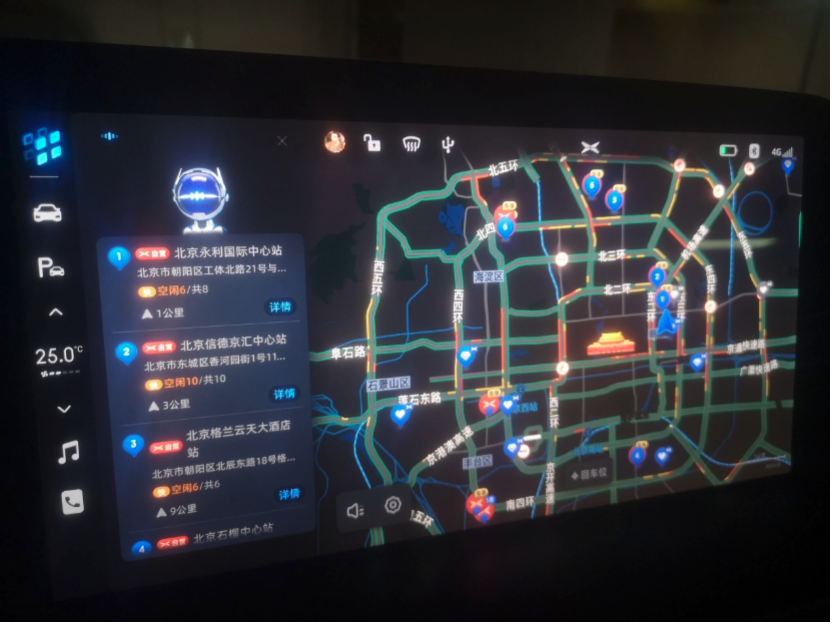
Now I can select the charging station on the big screen. My friend specially reminded me to use the supercharger because the APP is bound to the account and can enjoy the privilege of 3000 kWh of free electricity per year. It’s really amazing. Let’s go and charge. There is an exclusive charging station very close to where we are, which is free and allows us to enjoy the pleasure of charging for free.
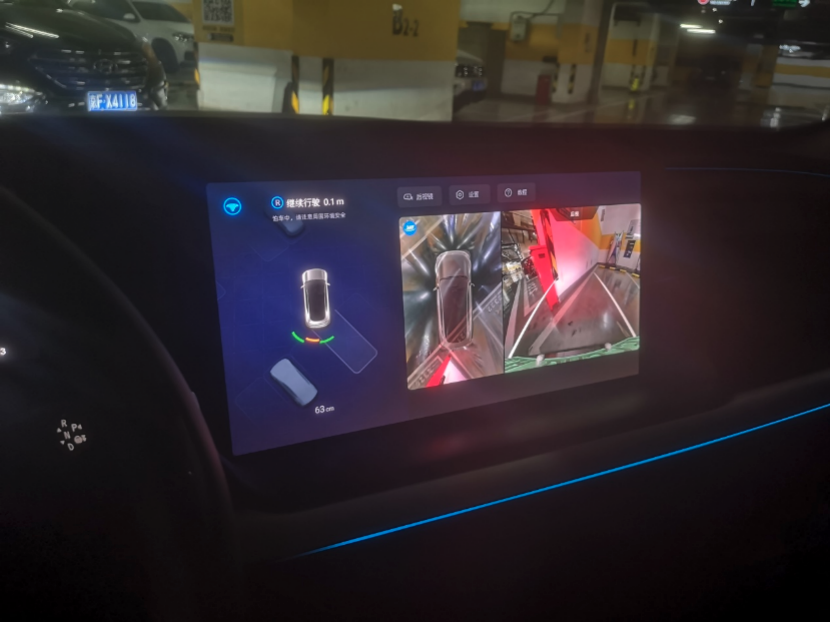
It’s just the right time to experience the automatic parking.
Easy-to-use automatic parking

I have to say that the logic of the automatic parking is very good, and the parking is very precise. There is no phenomenon of turning the wheels in place when the vehicle is moving. It’s 100 points for the technology. However, the parking space is too close to the wall, and it’s a bit difficult to get off the car… Since it’s not my own car, I have to take good care of it. I am worried about bumping into the paint surface when opening the door, so I had to change to another parking space to charge.
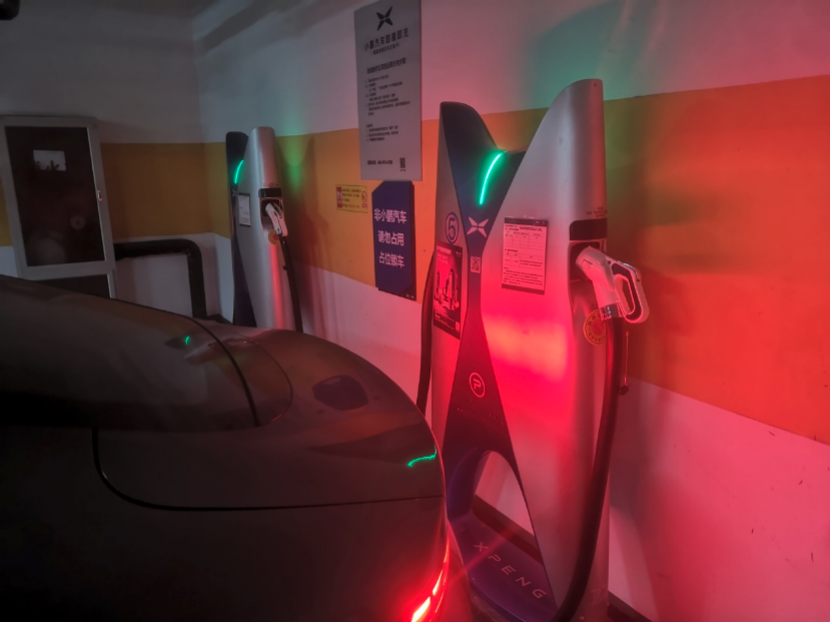
The charging process is very simple, just plug it in.
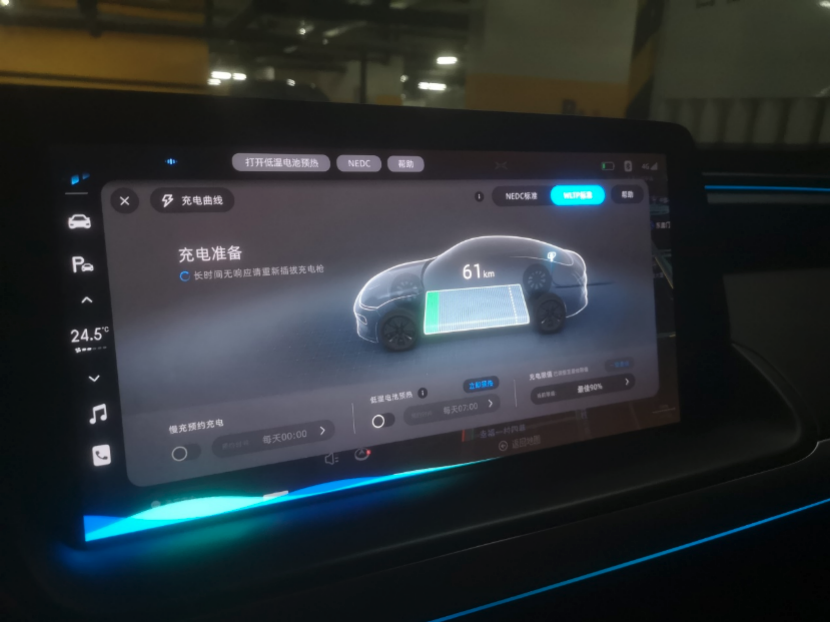
While charging, I took a closer look at the car’s system. The main display is a 14.96-inch center screen, which is connected to the dashboard, with a resolution of 2400×1200 and a delicate display effect. I think the size is quite appropriate. Having a large iPad in the center console is impressive, but not necessarily practical. It looks a bit weird, and the visual effect is not coordinated.
Air Conditioning
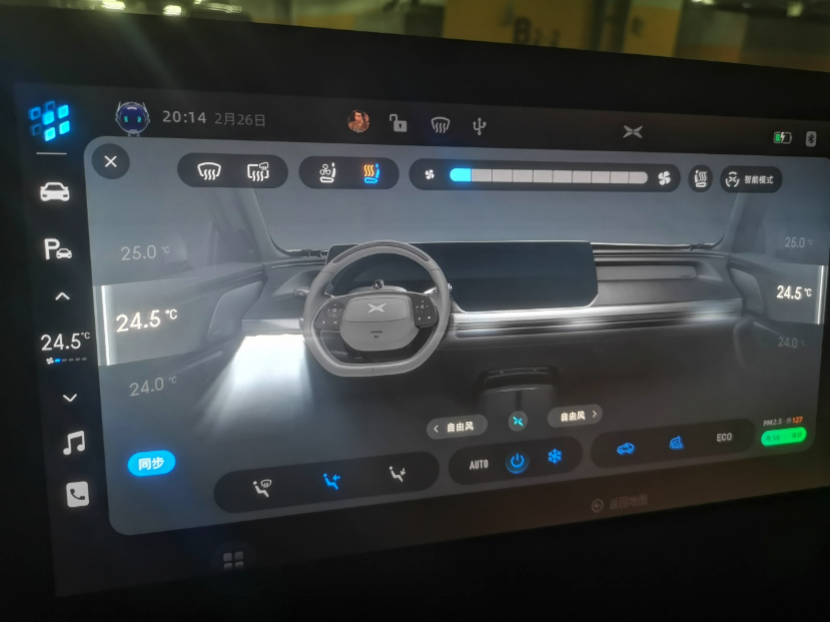
The way the air conditioning is adjusted is the same as that of Tesla. You can slide on the screen to adjust the direction.
Easter Egg
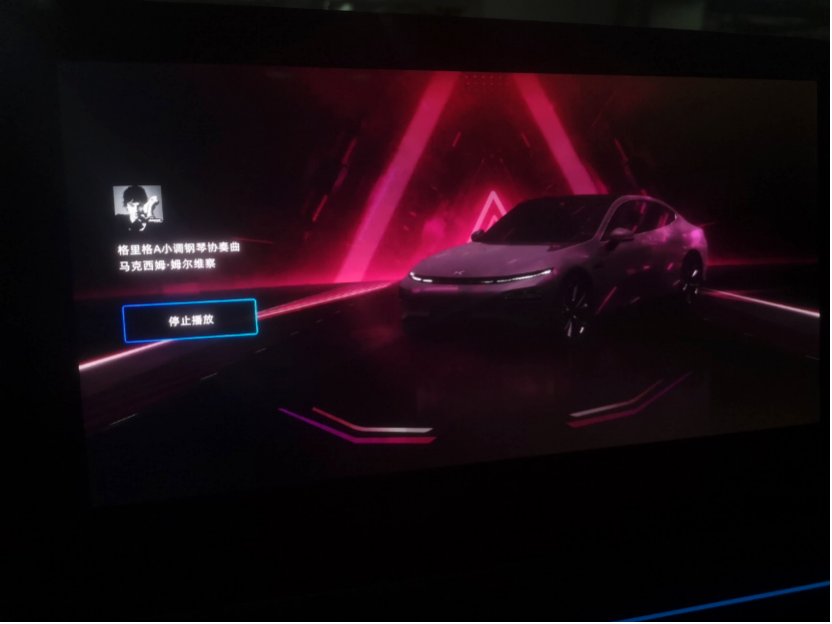
This light strip mode is quite interesting and can create atmosphere.
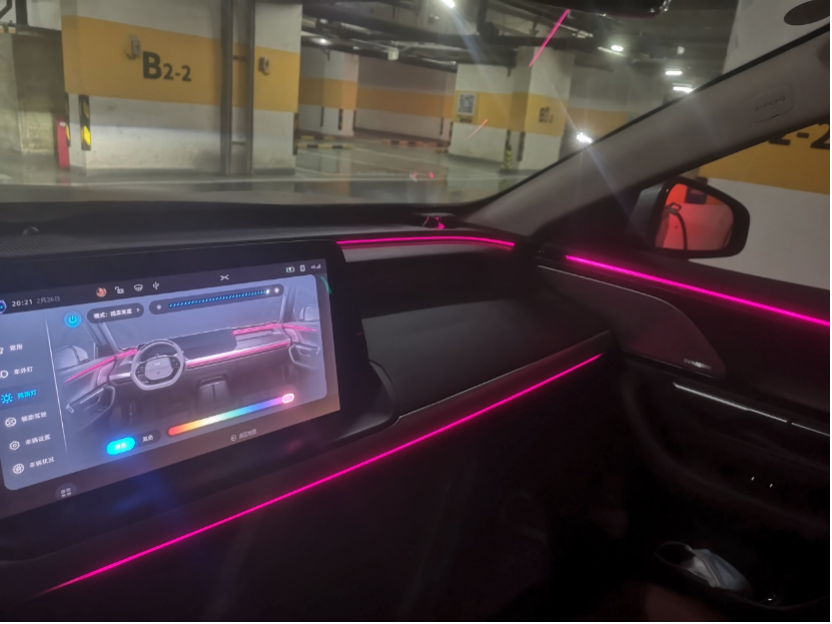
The ambient lights can be fixed or adjusted with the speed of the car, or move in time with the music. The colors are very diverse, of course, I chose the ambiguous pink light mode.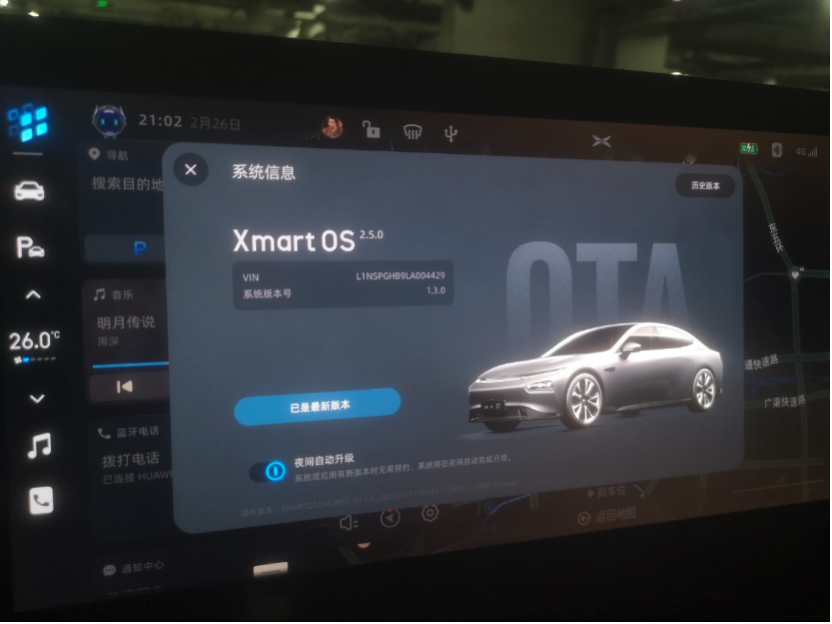
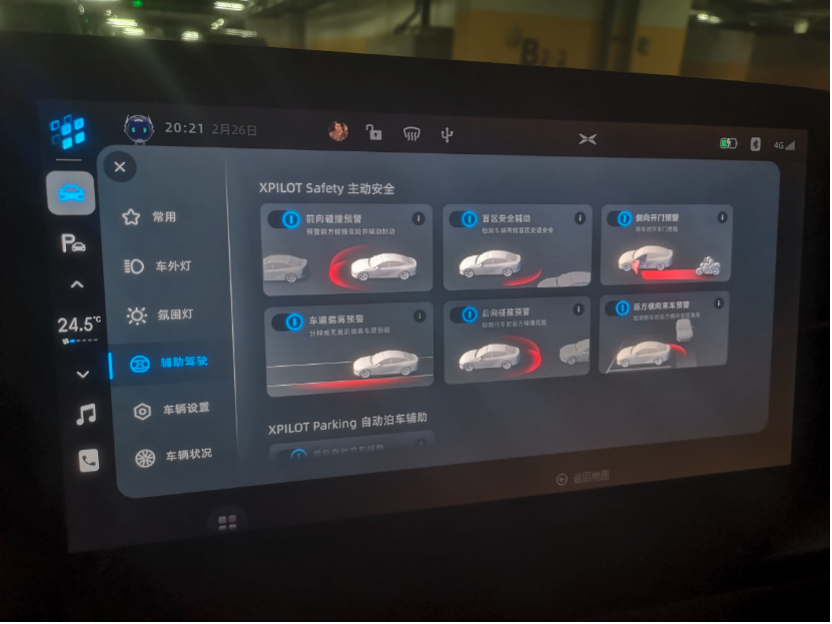
This P7 comes with the latest Xmart OS 2.5.0 system, but it doesn’t have NGP, so it can’t experience automatic navigation assistance, which is a pity.
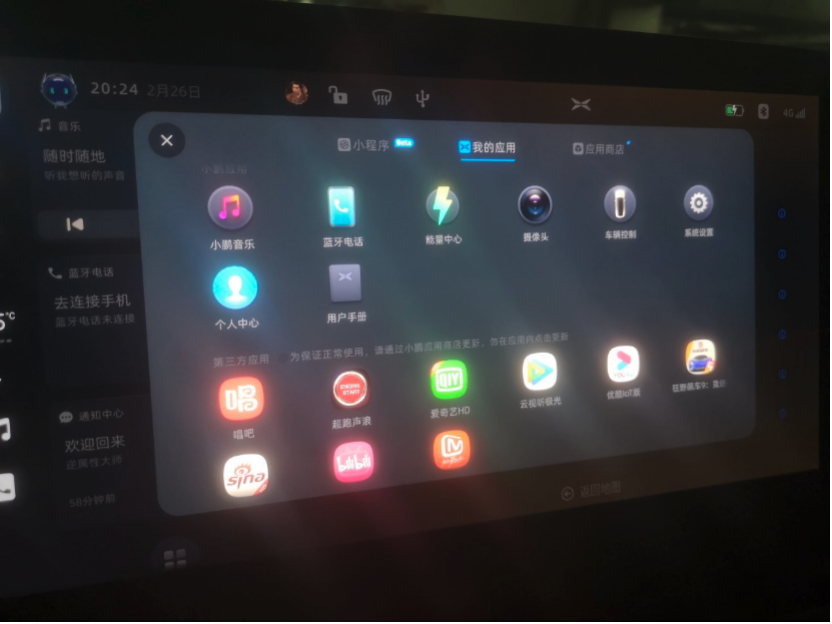
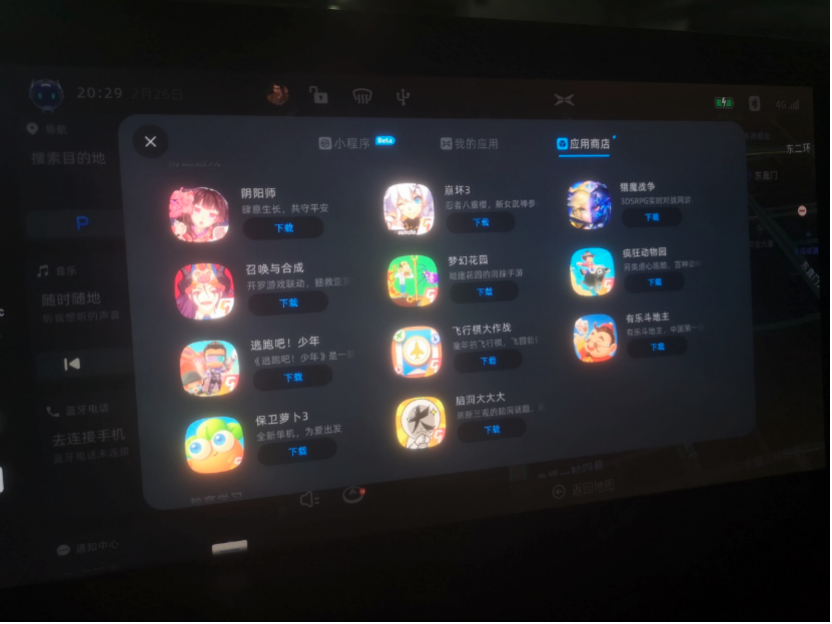
Software Expansion
There are still many application extensions available, such as video, games, and KTV. And they are quite compatible with the system, which is great news for TV show fans, KTV lovers and gamers.
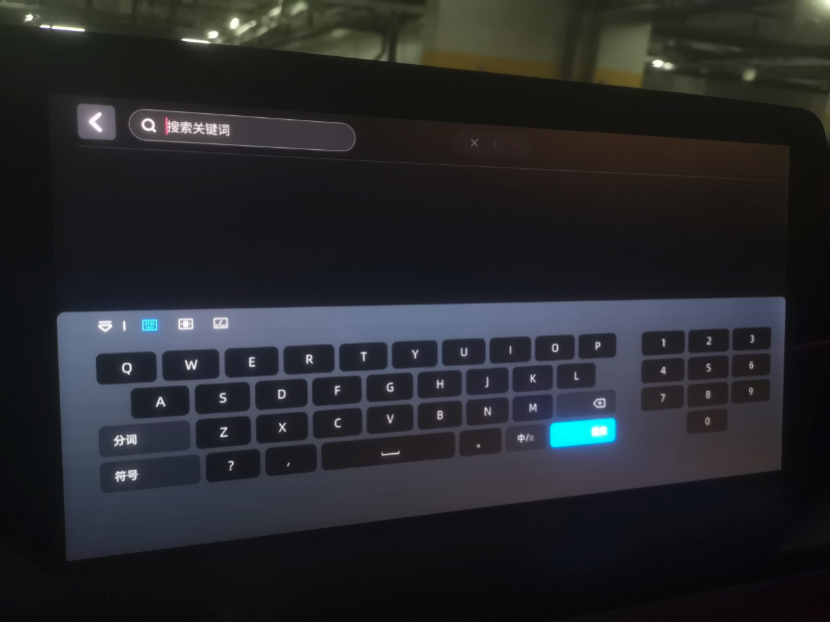
But when I tried searching for an app using voice input, I failed.
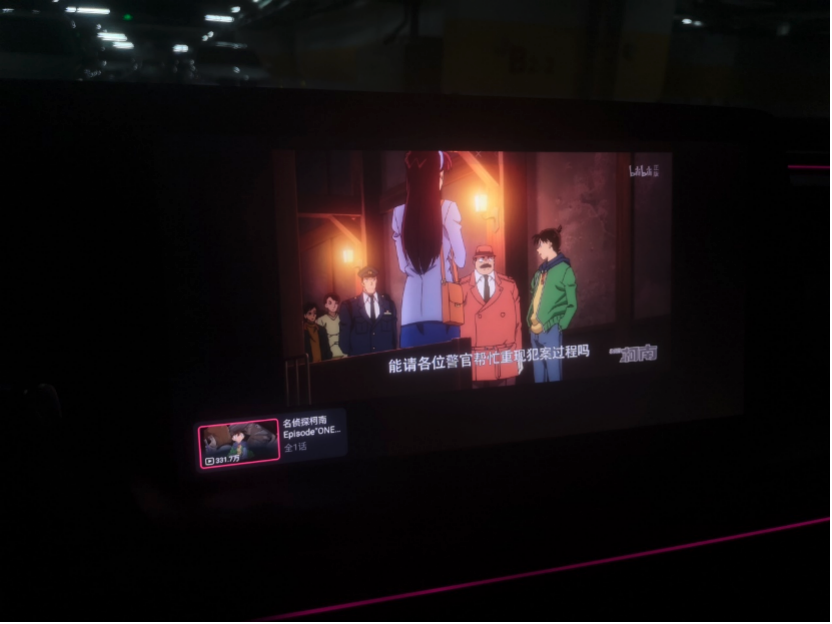
The video resolution is satisfactory, and the co-pilot should like this feature.
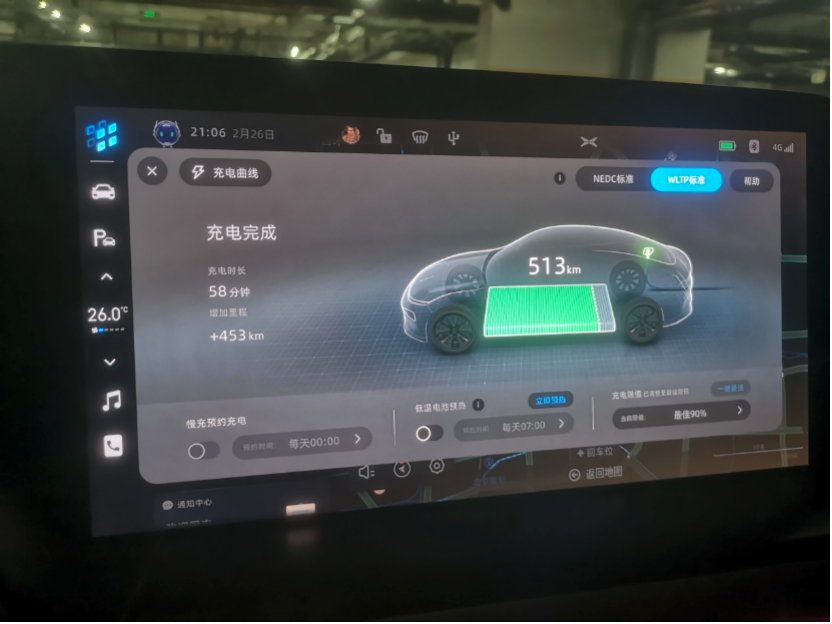
Charging
Charged to 90% in 58 minutes, and the range went from 61km to 513km.
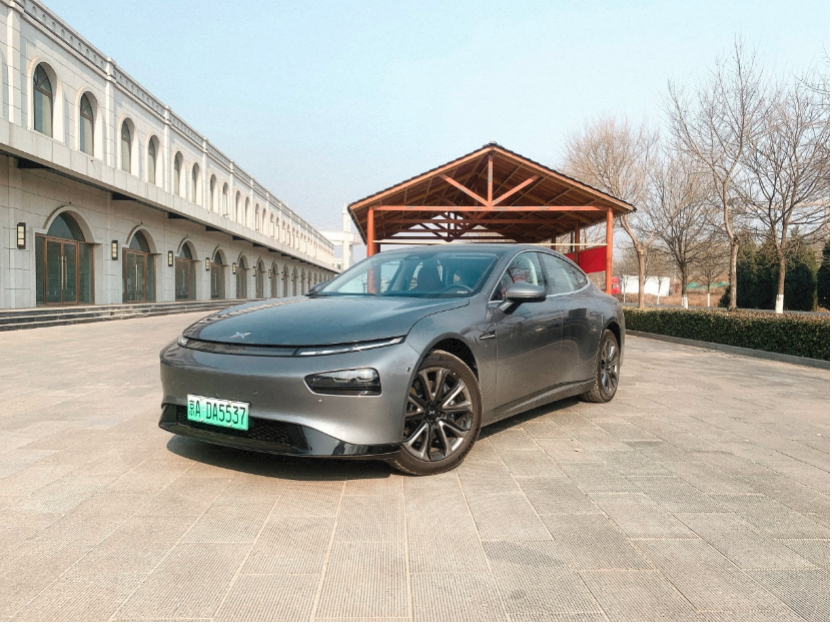
Appearance
The weather was nice on Saturday, so I took some photos of the P7. The closed grille and the through-type semi-curved headlamp line make the front face of the P7 stand out on the road, and it definitely attracts a lot of attention.
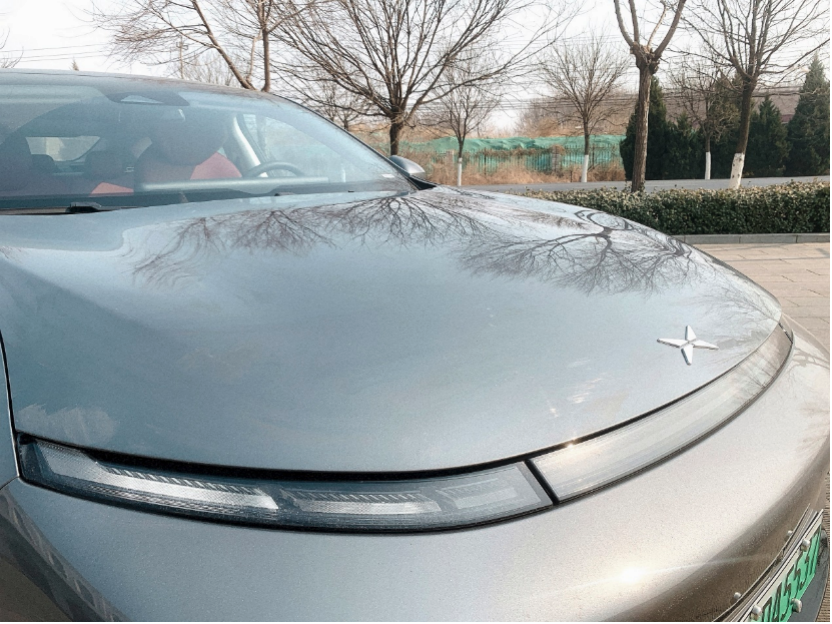
Under the LED light strip are the LED headlights, which is an increasingly popular split design. At first, I thought it looked weird, but I slowly got used to it, and even found a sense of fierceness in its cuteness.
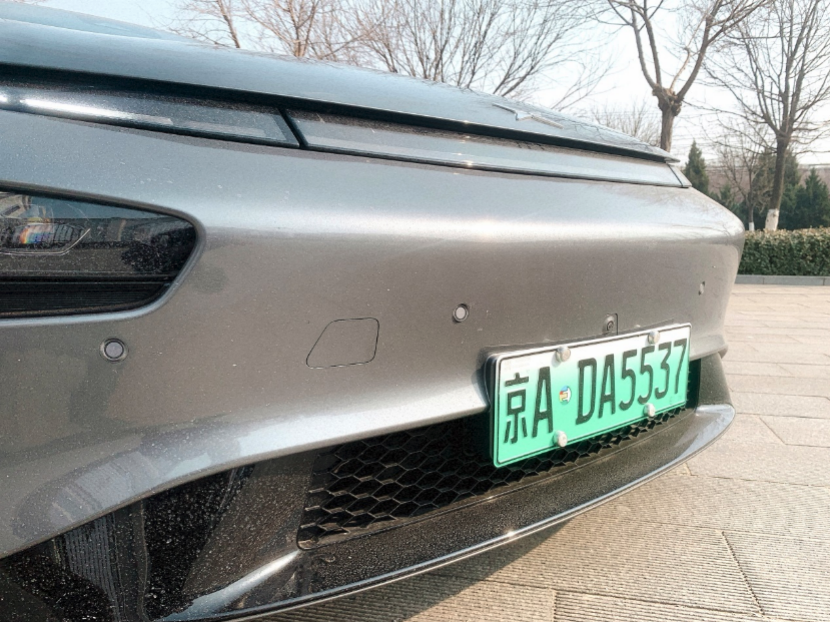 The distribution of radar and cameras did not affect the overall design effect. The assistance of driving technology and the help of these radar and cameras are inseparable.
The distribution of radar and cameras did not affect the overall design effect. The assistance of driving technology and the help of these radar and cameras are inseparable.
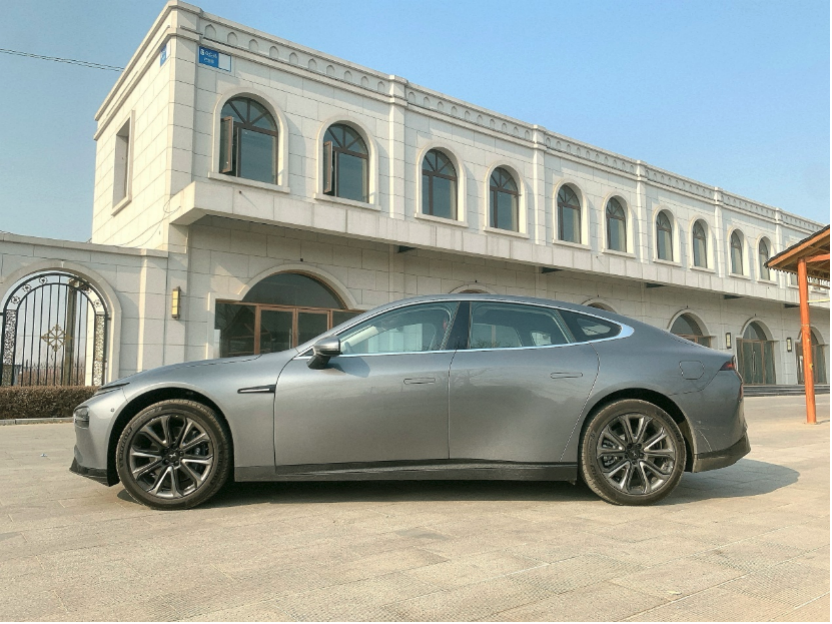
The length of XPeng P7 is 4880mm, with a wheelbase of nearly 3 meters (2998mm), and a drag coefficient of only 0.236cd. With hidden door handles and a smoothly textured back, the overall effect is elegant with a hint of sportiness.
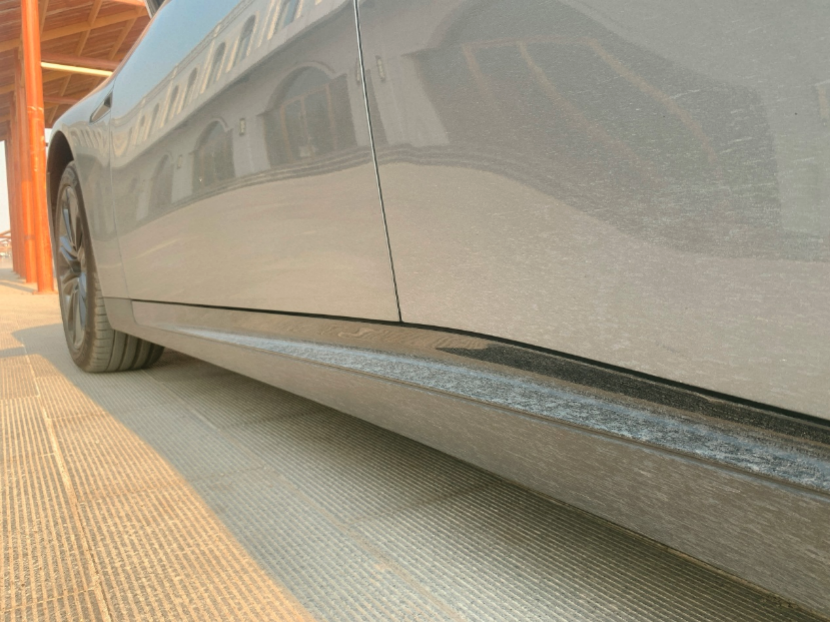
It is unclear whether it is related to the drag coefficient, but the ground clearance is really low, and there are concerns about bottoming out. The non-uniform color of the body also feels a bit awkward visually.
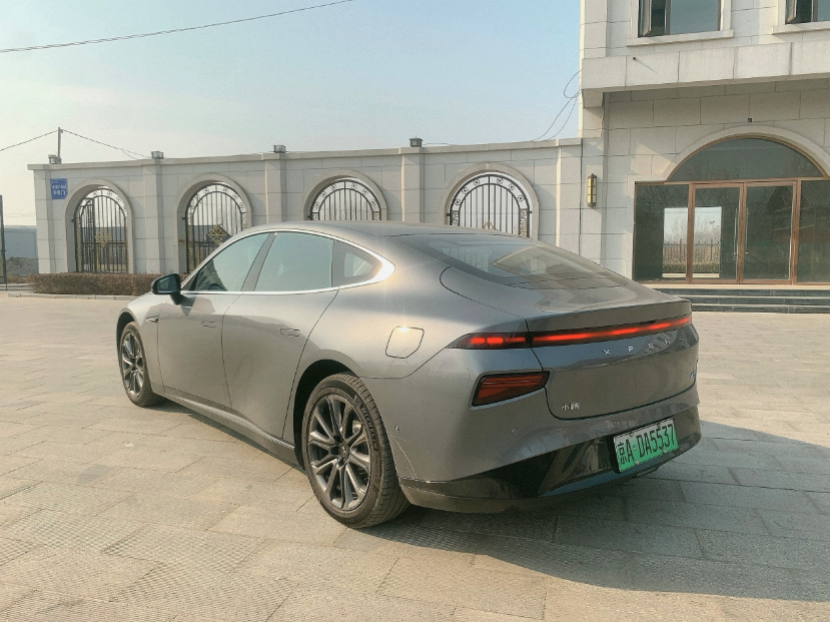
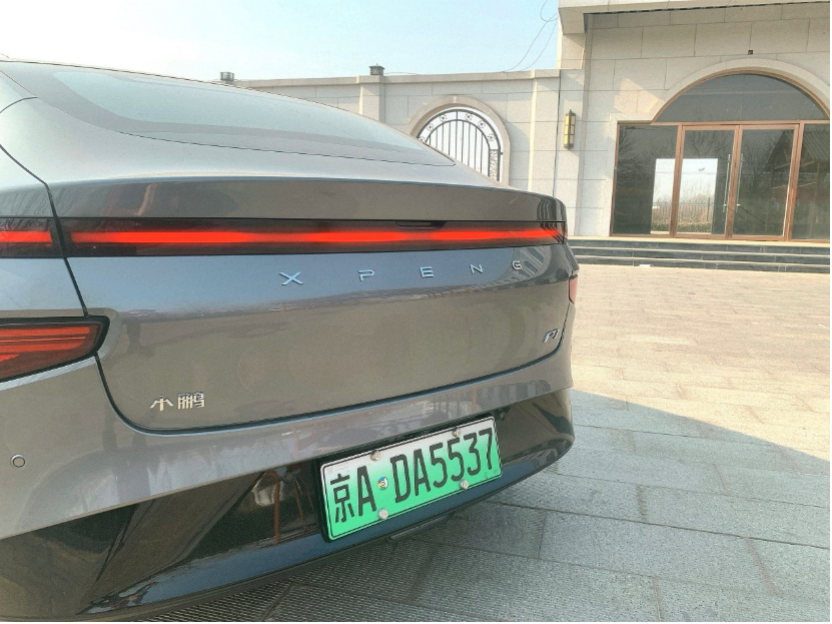
The rear end is also designed with a through-light strip, with split taillights underneath that are in line with the front face. The letters XPENG are fine, but the two Chinese characters for XPeng look really awkward. I was almost put off by the name before I looked into this car in detail.
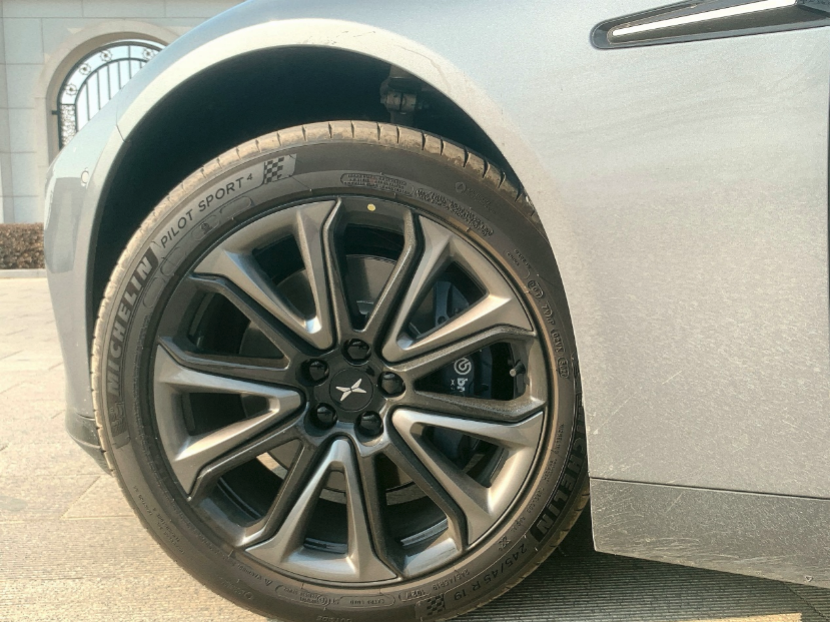
The 18-inch wheel design is neither good nor bad, but it looks much better than the large cover on Tesla’s wheel. The Brembo brake calipers on the front wheels give a strong impression of quality, which is worth it even though only the front wheels have them. In fact, the braking effect is quite good. When stepping on the brakes, the vehicle brakes smoothly and steadily, but there is some nodding when it has to brake suddenly. However, this car has traveled more than 9000km, and there are some complaints about the brakes, which will be discussed later.
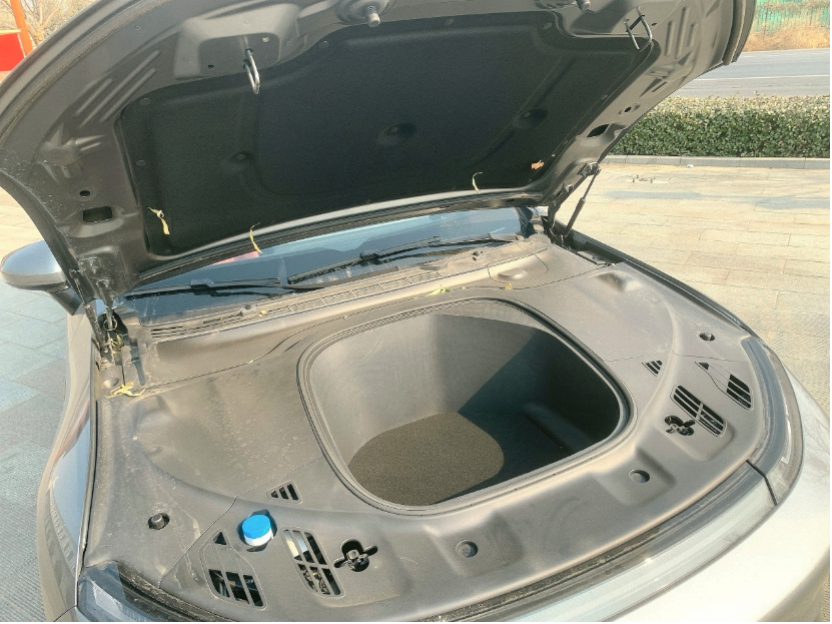
The front trunk is originally a practical and high-end design, but it can only be opened with a physical handle from inside the car, which basically turns it into a disappointing feature. Moreover, it is difficult to close because you need to press the left side and then the right side before the buckle can be fastened.
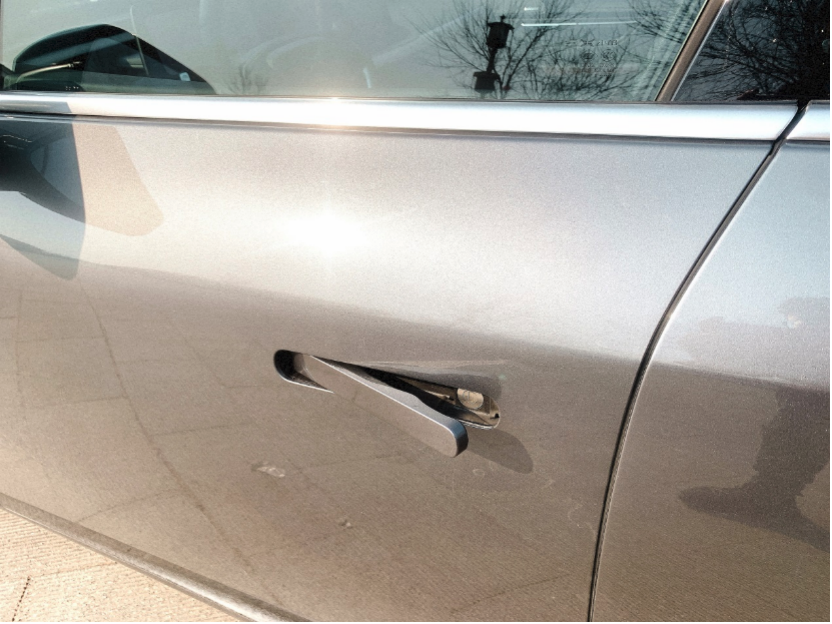
The hidden door handles, when popped open, are paired with a start-up sound that gives a sense of ceremony.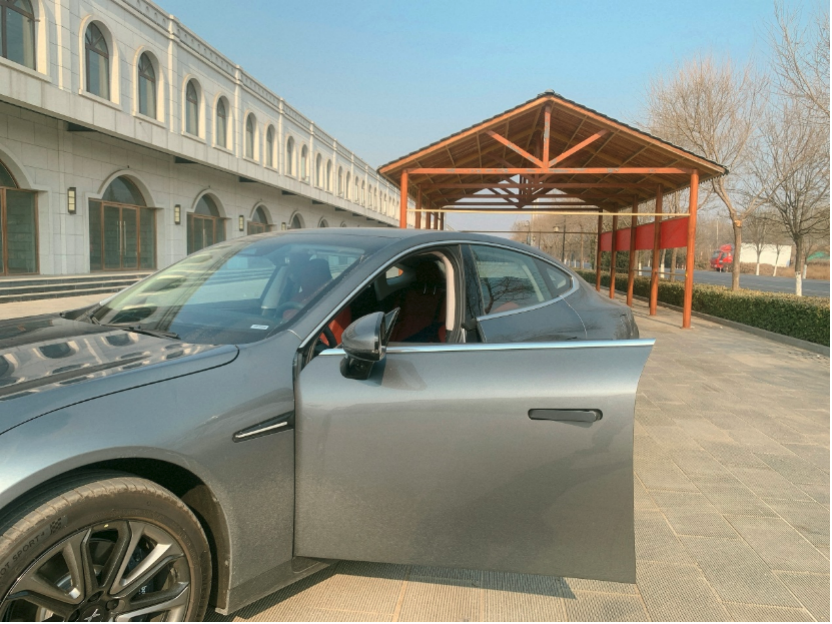
No-framed car doors with heavy closing sounds. The overall noise control of the XPeng P7 is good, and it remains relatively quiet even when accelerating to 80. Thinking of my Mazda, it roars above 80…
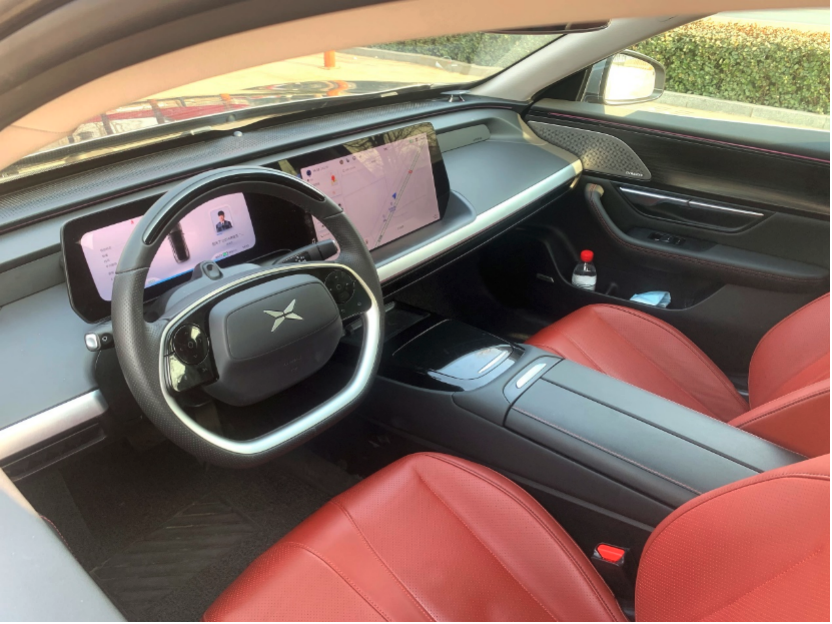
Interior
Intelligent car interiors tend to be minimalist, and the XPeng P7 is no exception, with almost no physical buttons and relying on voice control and the center console to operate.
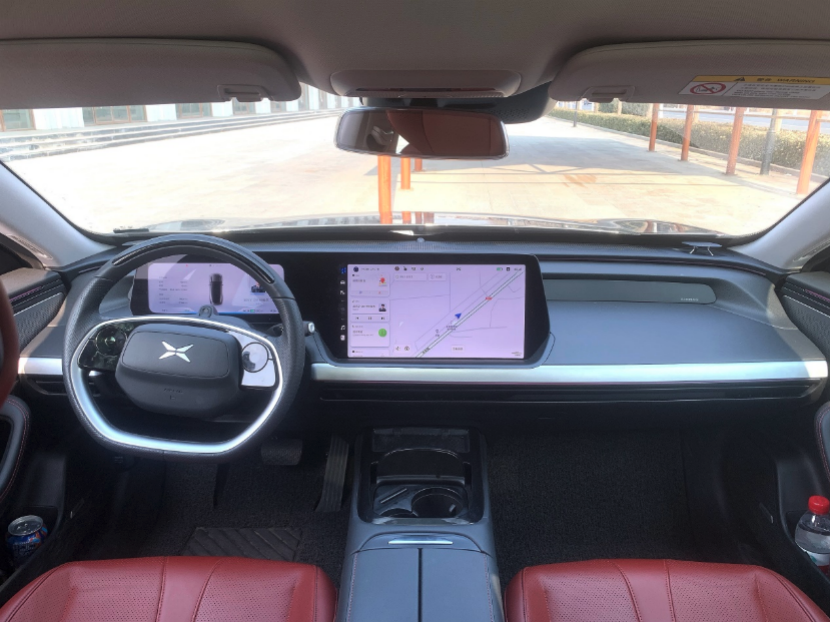
This kind of interior style may not have a sense of luxury, but it is a trend that is more conducive to human-computer interaction to achieve command delivery. Although I still feel that physical buttons are more direct in the short term, but after a while of use, the habit has formed and I can’t go back to physical buttons.
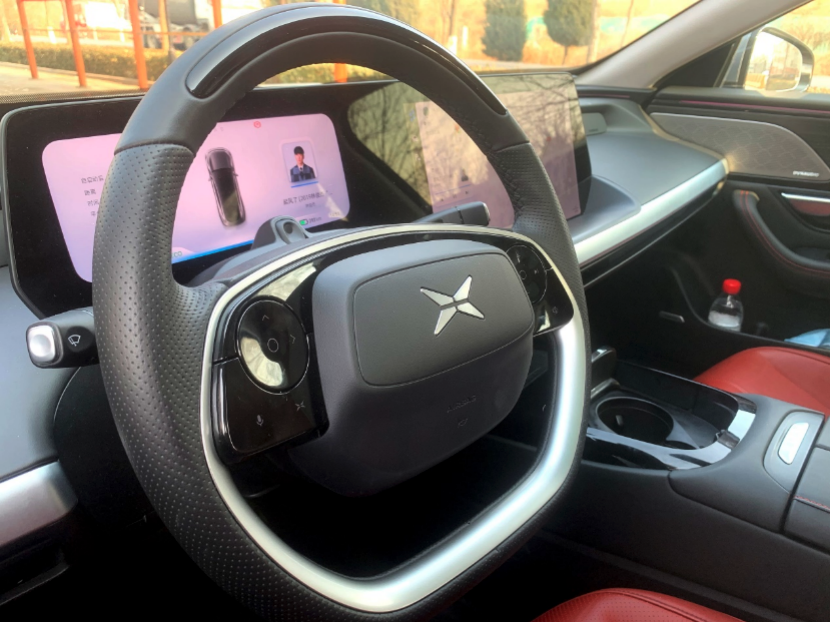
The double-spoke steering wheel has a smooth feel with the touch part made of piano baking paint. However, maybe because I’m used to three-spoke steering wheels and the sporty feeling that comes with it, I felt a bit uncomfortable with the double-spoke at first, but gradually got used to it after two days of use.
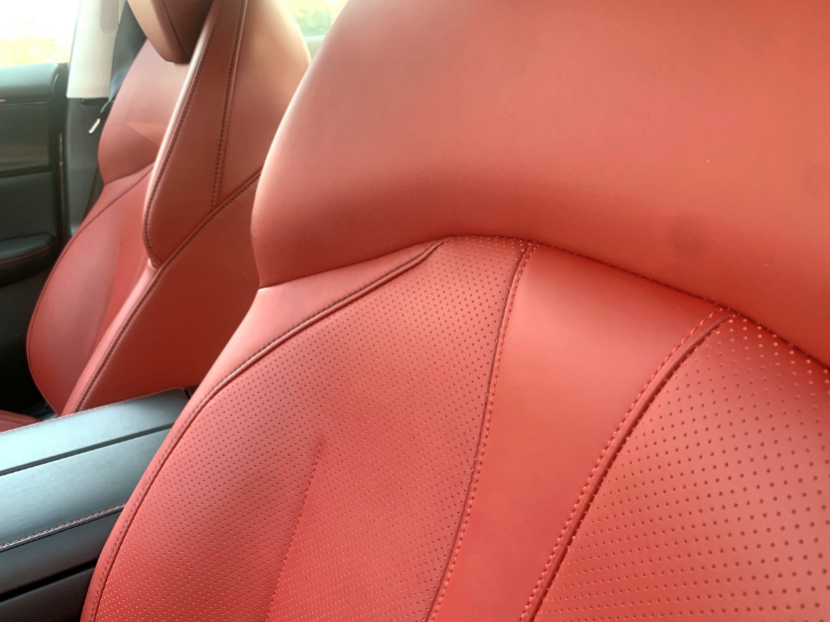
The sporty red interior is unique to the Denon sound system.
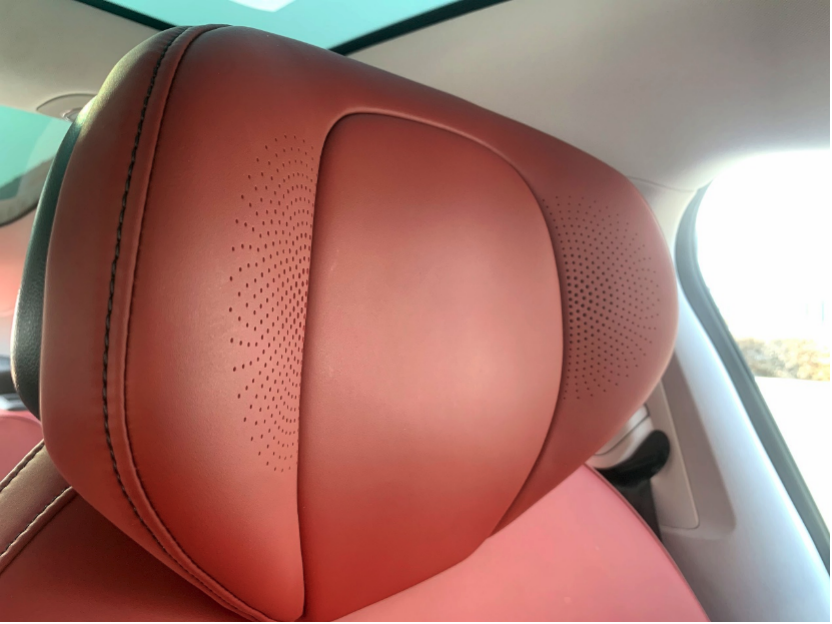
This red color is more towards burgundy, and my wife is very satisfied. Both of our cars at home have black interiors and we’re tired of them, but the P7’s sporty red “is refreshing, and the tone is very comfortable, making it feel upscale,” according to my wife.
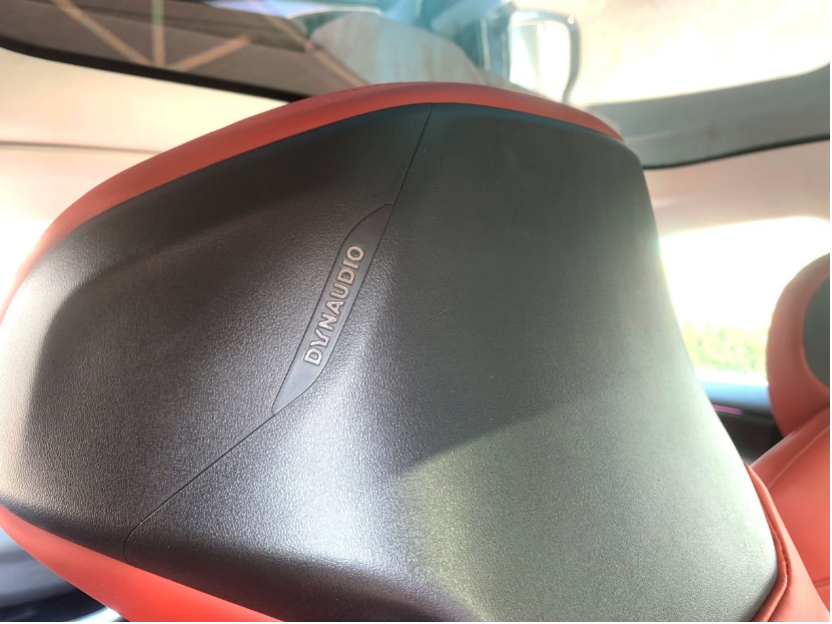
There’s also a Denon sound system behind the headrest, the B-grade sound is awesome~~
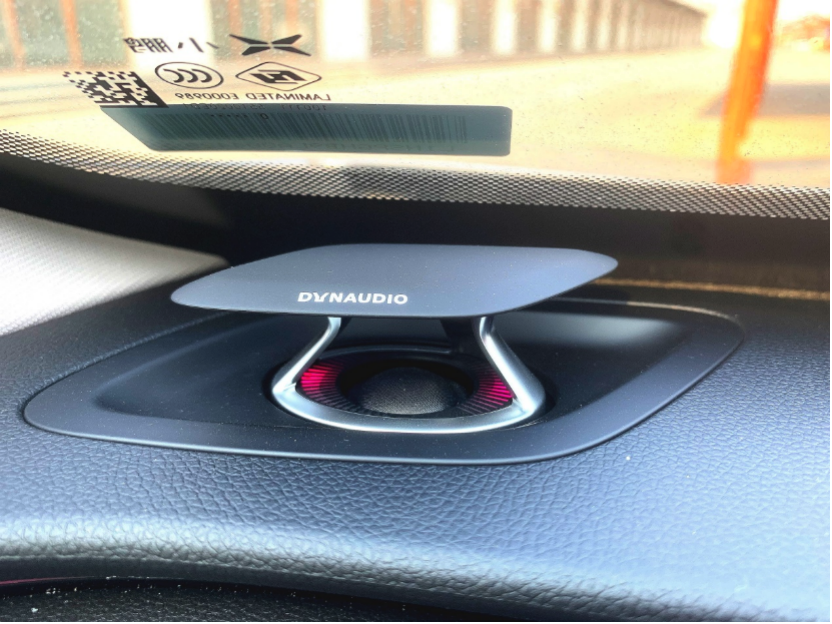 I’m ashamed to say that as a frequent user of 15 yuan earphones, I really don’t understand audio equipment. I can’t describe whether the bass or treble is awesome like the professionals. However, I can say that the sound quality is really good, better than the audio in my two cars at home. You get what you pay for. Additionally, the audio system will receive OTA updates in the future.
I’m ashamed to say that as a frequent user of 15 yuan earphones, I really don’t understand audio equipment. I can’t describe whether the bass or treble is awesome like the professionals. However, I can say that the sound quality is really good, better than the audio in my two cars at home. You get what you pay for. Additionally, the audio system will receive OTA updates in the future.
According to the official app, the Dynaudio sound system is included in a 18000 yuan optional package, which also includes carpets, Nappa leather seats, and corresponding interior themes. The texture is pretty good, soft and delicate to touch. When compared to other brands’ Nappa seat upgrades, XPeng’s package is not expensive. However, it may be a bit awkward for those who like sporty red interior but don’t care about the sound system. I hope XPeng can consider this problem and allow car owners to choose the desired configuration.
The driver’s seat can be adjusted in eight ways, including heating and ventilation functions, which is very comfortable and provides support for the waist. The passenger seat has only heating and height adjustment.
The two-section sealed panoramic sunroof makes the space feel bright and spacious when sitting inside. There is no sunshade, and I’m unable to judge whether it is sunproof, as it hasn’t been too sunny in Beijing in recent days. Can any car owners describe how well the sunroof works in summer? Actually, it would be nice to have a sunshade.
The storage space is quite sufficient, matching the level of medium-to-large-sized coupes, and can provide wireless charging.
The back seat has air conditioning and two USB charging ports.
As you can tell from my family car, the rear space is not that important to me since I usually travel with two people or less, occasionally with someone in the back seat. The P7’s wheelbase is close to 3000mm, and space is not an issue for me. I’m 174cm tall, and there is not much pressure sitting in the back after the front seat is adjusted properly.## Trunk
The coupe-like design of the car results in a relatively small trunk opening.
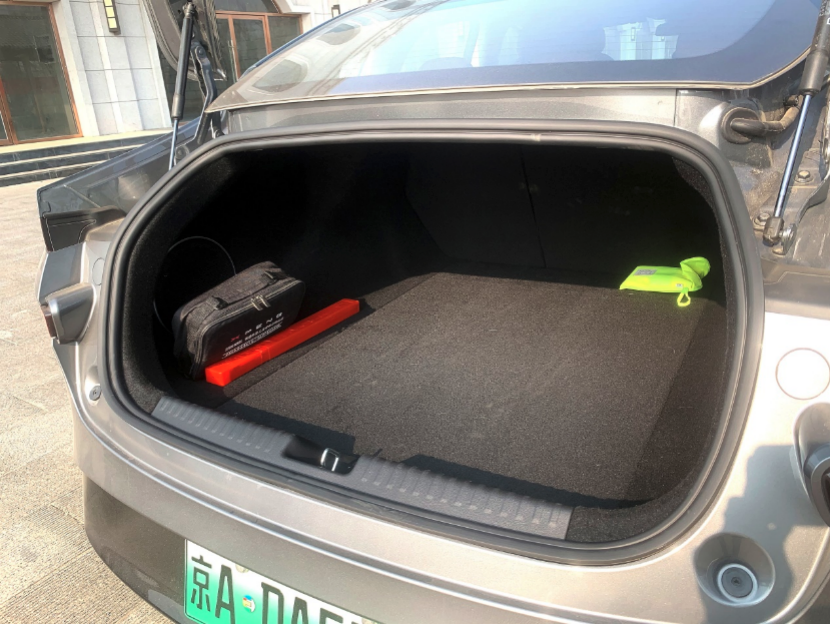
Although the longitudinal depth of the trunk is fine, it may be a bit awkward to access items that are deep inside.
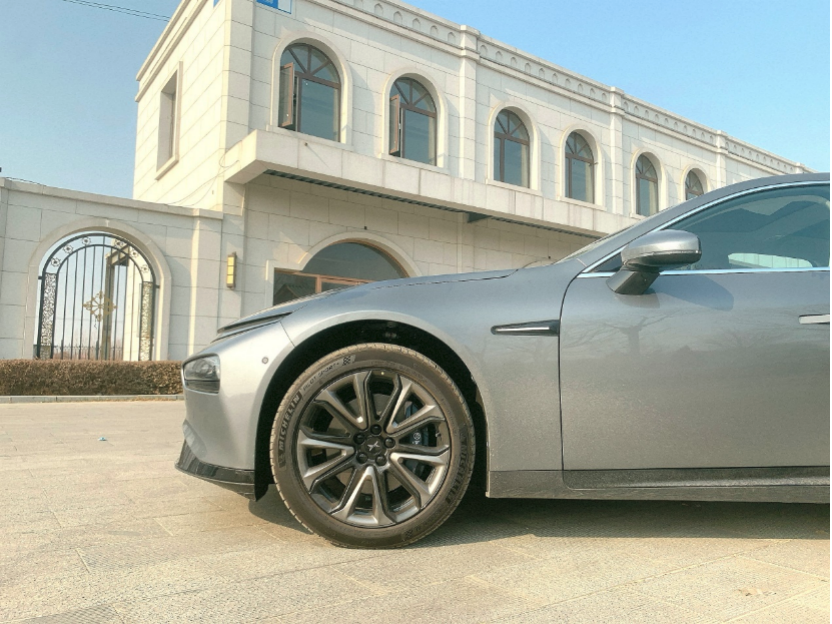
Driving Experience
As a small electric car, the pushback feeling is noticeable when stepping on the accelerator pedal for the initial acceleration. Since there is no shifting involved, the overall acceleration process is very smooth.

Although the car is almost 5 meters long, there is no sense of sluggishness during lane changing maneuvers. By using the lane change assistance system and predicting the distance ahead of time, lane changing can be done effortlessly.
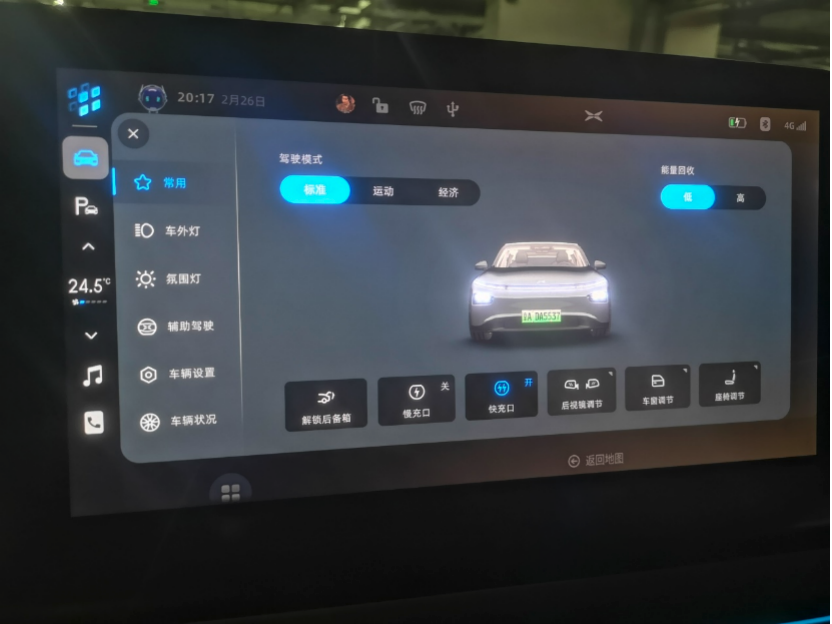
I generally set the car to standard mode with low energy feedback. The overall tuning of the car is biased towards comfort. The suspension is very soft and filters out most vibrations, making it more suitable for daily usage. In this mode, the kinetic energy recovery can be ignored, which does not differ much from gasoline-powered cars.
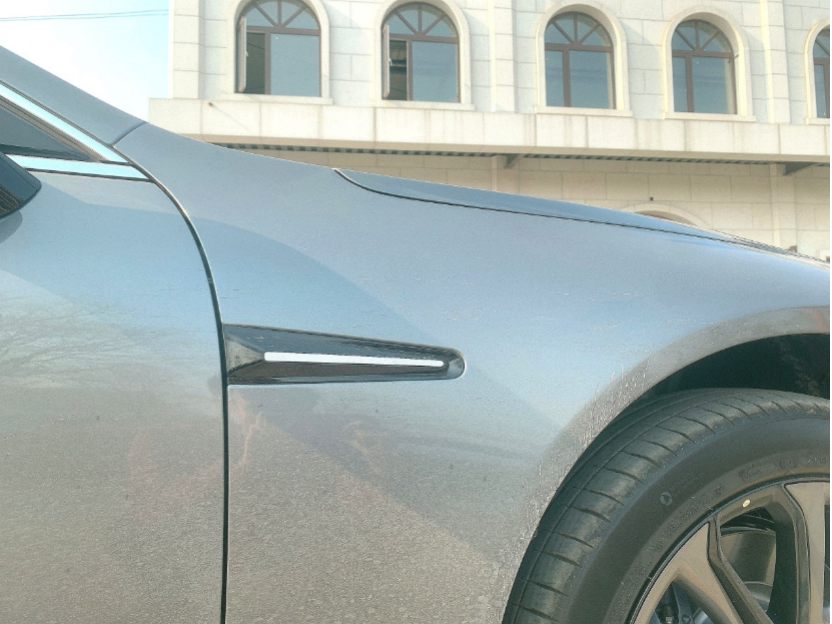
If switched to sport mode, you can feel the 6.7s 0-100 km/h acceleration claim of the XPeng P7. The fierce instant acceleration can satisfy the needs of most users. The output is smooth, confident, and feels controllable. (As an aside, when test driving model3P, the salesman hit the accelerator pedal full force, which was more thrilling than a roller coaster. I think it’s pretty good, but my wife said she felt sick and didn’t approve of buying a high-performance car because she thinks it’s a waste of money and unnecessary).
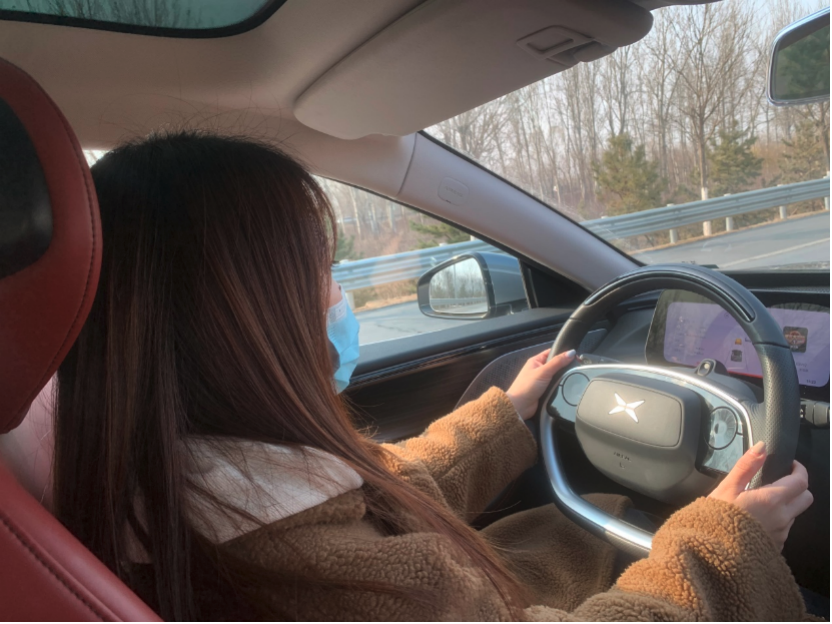
The steering can also be adjusted for weight, which is another user-friendly feature of the intelligent car. I prefer a heavier steering wheel, but my wife said it was too heavy when she tried driving. We quickly adjusted the turning force via voice interaction.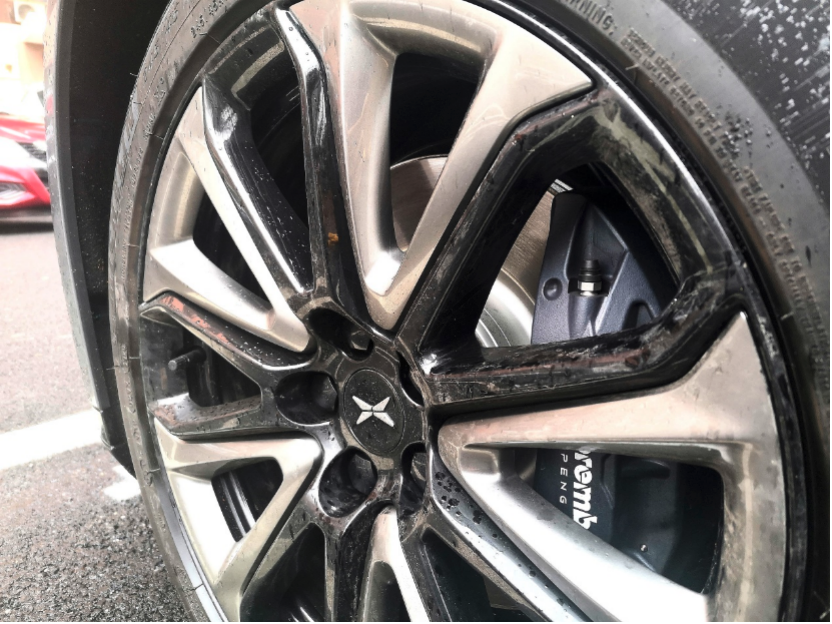
Let’s Complain
Of course, there are also some things to complain about. The most important one is that the brakes of this car, which has traveled over 9,000 km, make a severe noise. On the first day, I didn’t feel it much. On the second day, it rained in Beijing, and when P7 stepped on the brakes, especially during the slow braking at the end, there was a constant piercing scream.
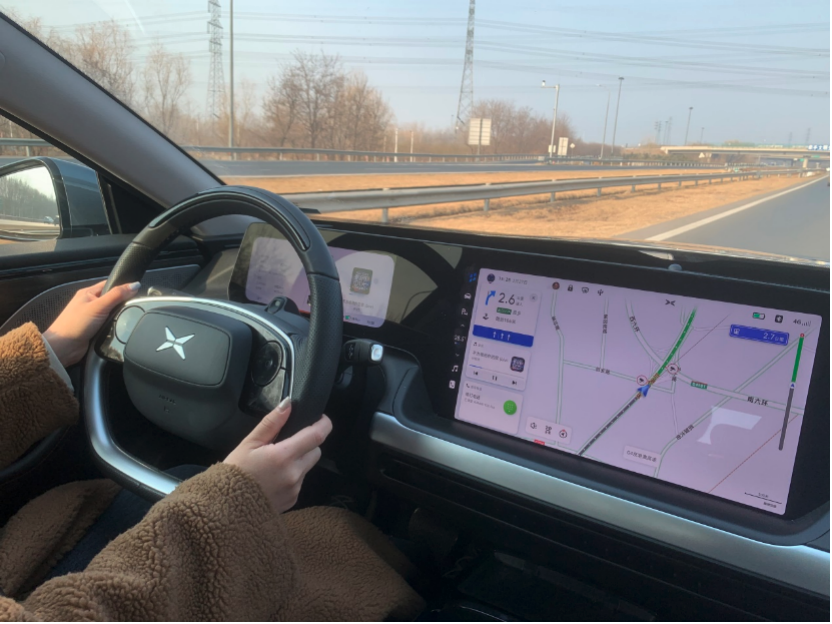
The central control screen realizes many functions of the vehicle. Compared with the car I currently drive, the biggest breakthrough is the navigation. As a company in the Alibaba ecosystem, XPeng Motors uses Gaode Map, and the success rate of voice-controlled destination input is basically 100%. During the driving process, the navigation is clear and understandable, and the prompt tone can be emitted separately from the headrest behind the main driver’s seat.

I personally like to check the trip data after the trip, such as the length of time and the average speed. This will appear after the navigation ends on the mobile phone version, but there is no similar data popping up after the trip ends in the P7. I don’t know if I didn’t find it?

The parking image is very clear and has a 360-degree panoramic view, as well as the function of transparent chassis, which is impeccable.
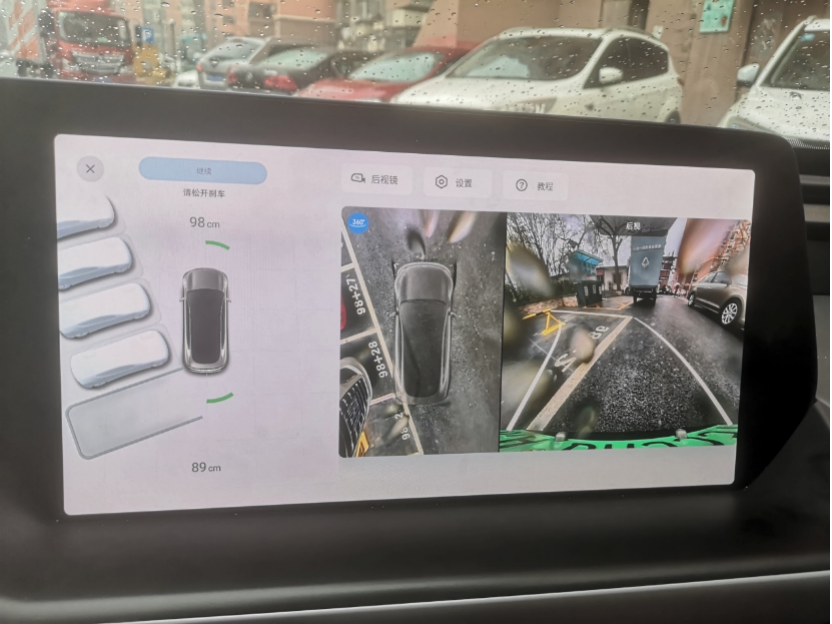
However, the next day, when I was parking automatically in a friend’s community, the parking space I found had a ground lock. Fortunately, I discovered the brake in time to avoid a tragedy.
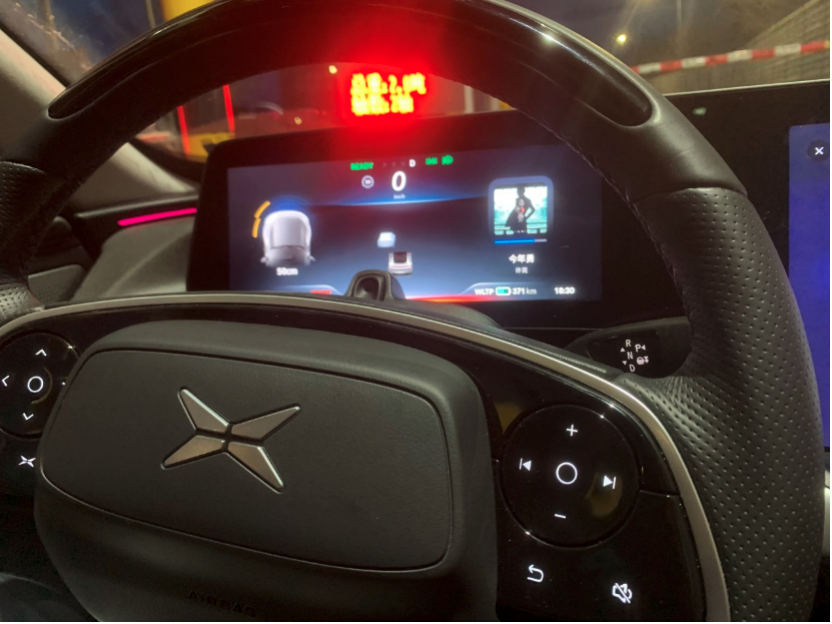
I originally wanted to let my wife take a picture of the radar sensing distance that appeared automatically at the toll station, but the dashboard was blurry. However, the multi-functional steering wheel was taken very well.
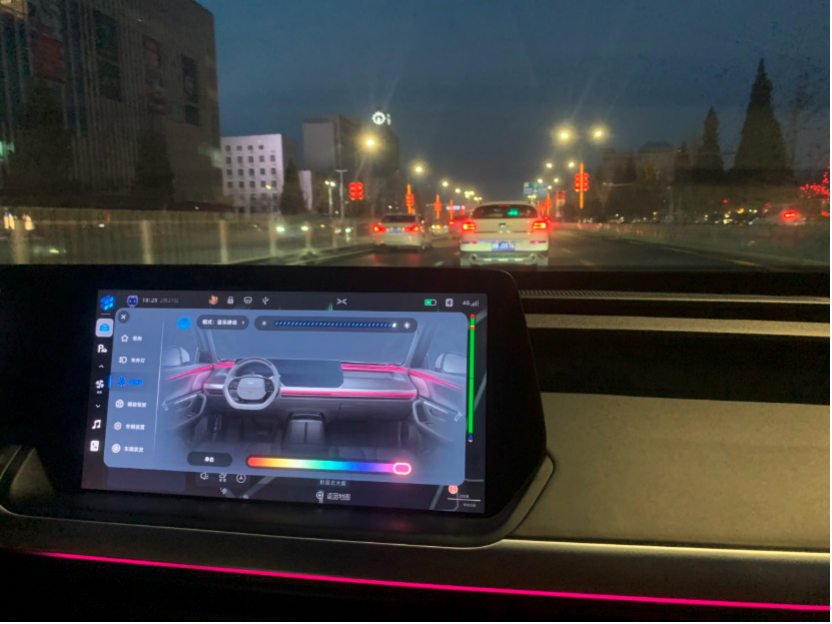
P7 does not have many physical buttons, and it is not too convenient to flip through submenus to achieve functions on the large screen, and it is easy to get confused and unable to find the target. Most of the time, it is controlled by voice. From the actual experience, it is still relatively well done for single program commands.
However, in situations where there is A+B, the car’s system may become confused and only execute one command. For example, if the command is to defog, it can be executed well. However, if there are two conflicting commands such as “defog” and “reduce fan speed”, the car’s system may not be able to understand or execute properly.
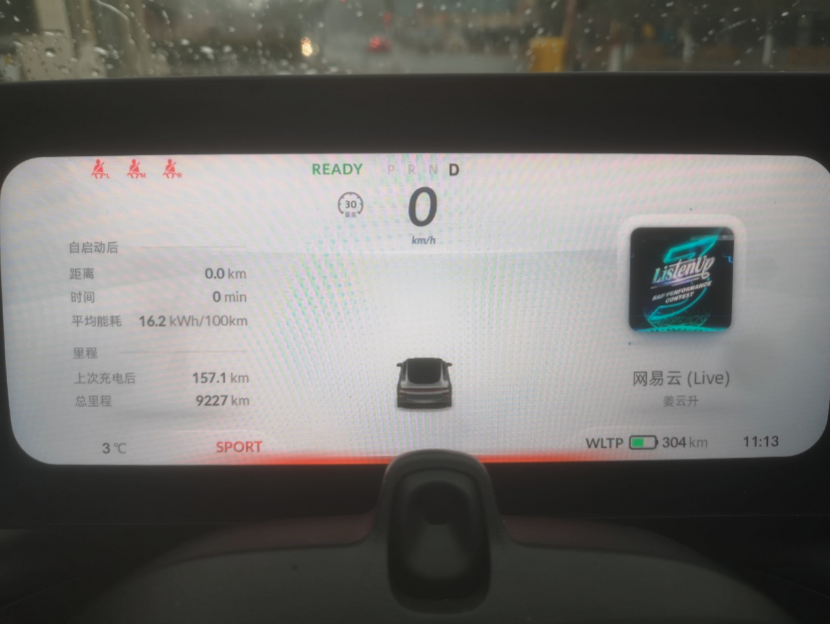
Furthermore, there may be cases where the car’s system misunderstands the command. For instance, if the user says “play Netease Cloud Music”, the car’s system might play a song called “Netease Cloud” on the KuGou music app, leading to confusion and frustration for the user. In such scenarios, it would be better to provide the user with options to clarify what they want, such as asking if they want to open the Netease Cloud app or play a song by the same name.
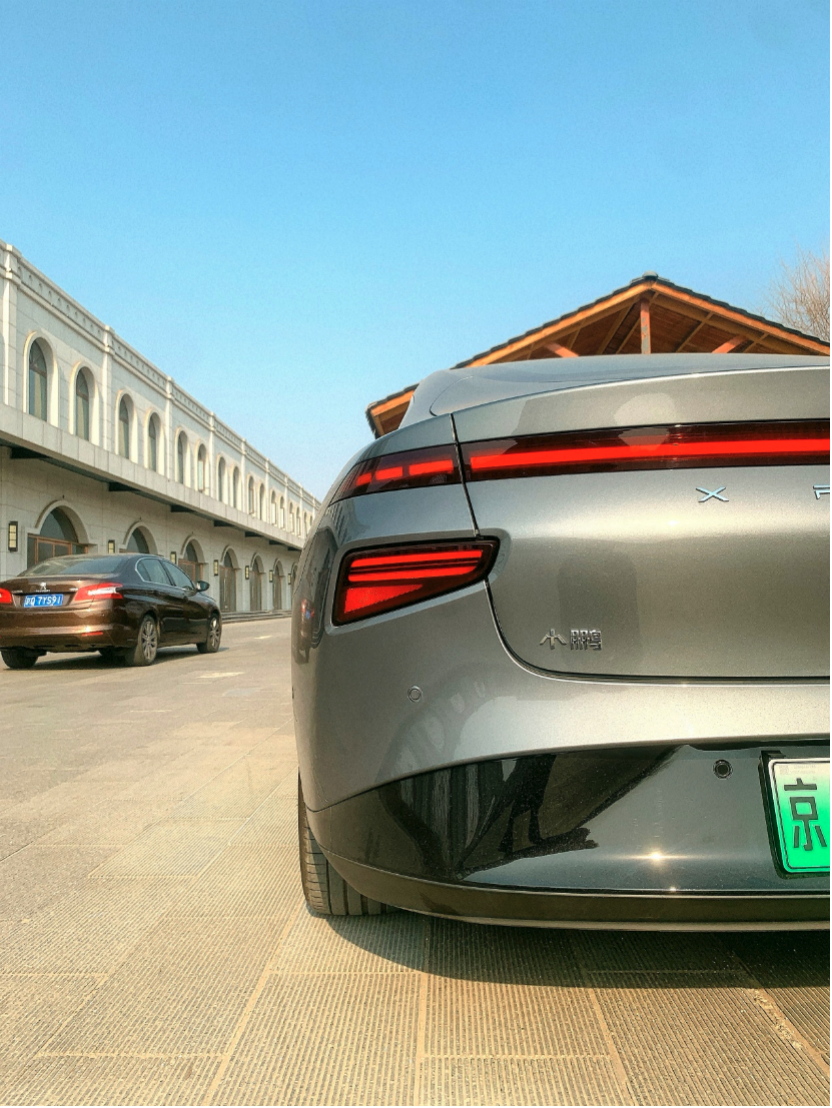
Advanced Driving Assistance
The P7 in question does not have NGP. I tried out its advanced driving assistance features on the highway, and found that the car can enter autonomous driving mode and follow the lane markings at a set speed when the driver flicks down the gear lever twice while in the middle of a lane.
Thanks to the numerous radars and cameras inside the car, the P7’s advanced driving assistance system accurately calculates distances and is able to control speed appropriately. Compared to driving manually, the P7 felt jerky in turns as the steering wheel felt like it was constantly adjusting. Meanwhile, drivers usually make smooth, curving turns.
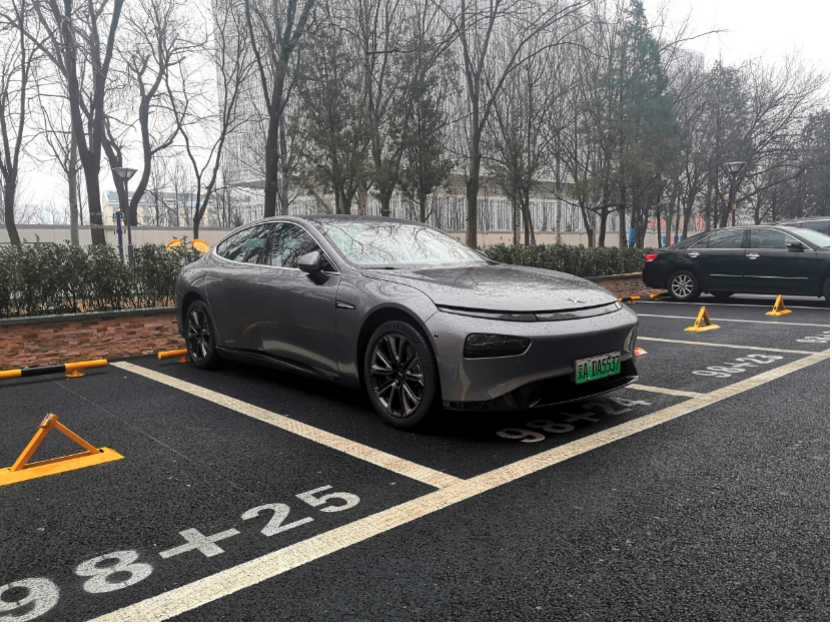
When the car detects a car trying to cut in, it will brake to prioritize safety. To change lanes, just use the turn signal and the car will change lanes automatically after confirming safety. The whole process was relatively smooth, and the dashboard will display an alert to indicate when the lane change is complete. Note that the turn signal must still be manually turned off.
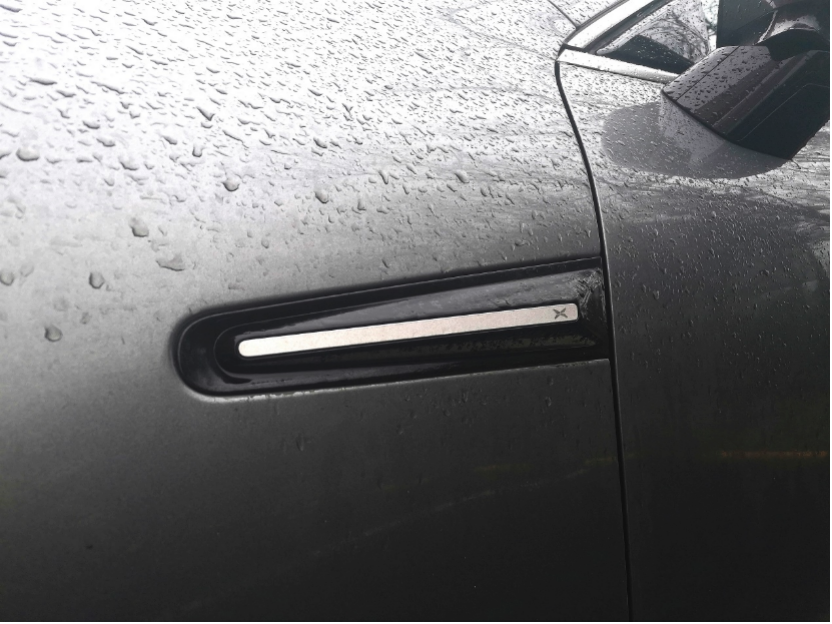
In practice, drivers may often choose another lane when the car ahead slows down or tries to merge, but the P7’s 2.5 version of advanced driving assistance cannot yet do that. However, NGP seems to be able to achieve this and can even automatically enter and exit ramps based on the navigation system. We hope to have the opportunity to experience this feature in the future.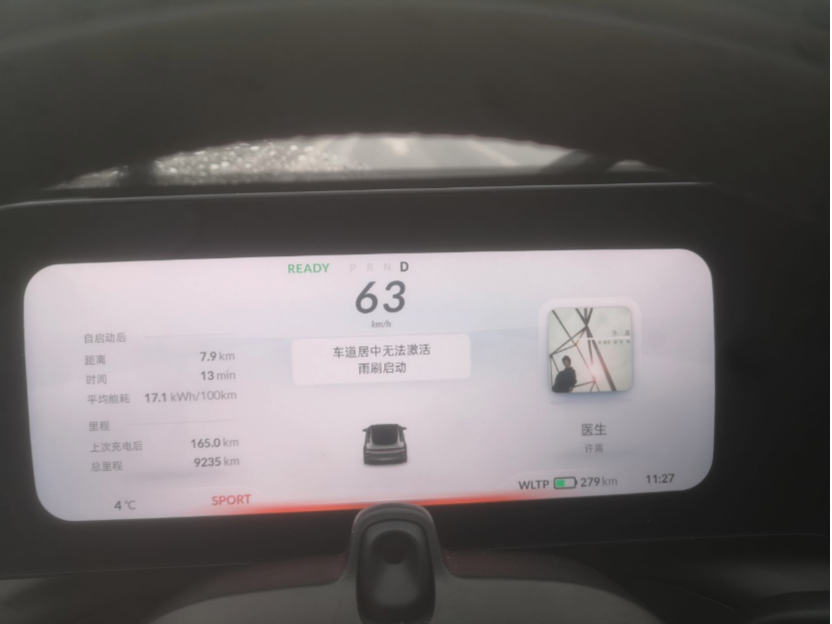
It rained in Beijing on Sunday, and the auxiliary driving function of P7 cannot be used when using the wiper. Indeed, road conditions are more complex in rainy days, and for now, it is more reassuring to drive by oneself. I don’t know if NGP can achieve rainy day driving.
Endurance
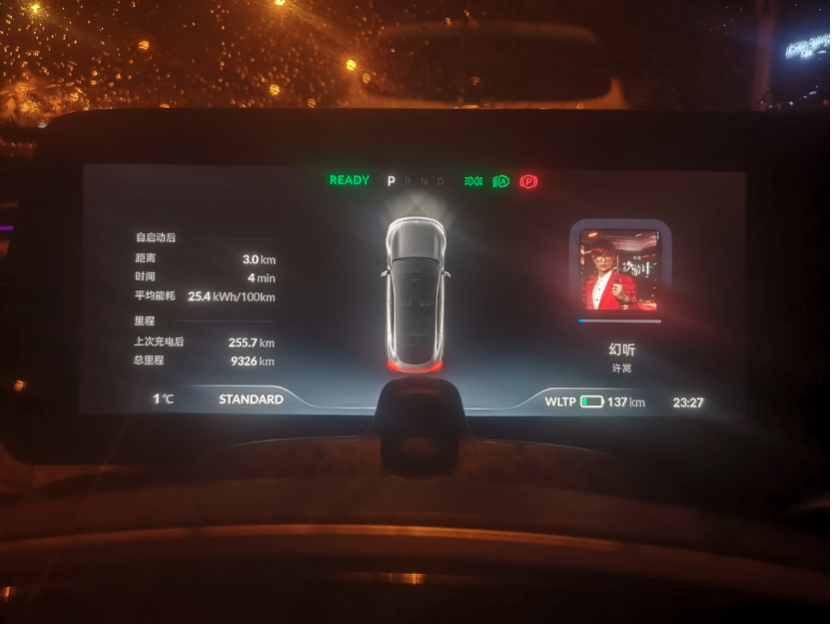
Finally, let’s talk about the battery life that everyone cares about. In two days, I drove a total of 255.7km, consuming 376km of WLTP range. The temperature range in Beijing during these two days was between 0-10°C, with light rain on Sunday, not warm, and every time I opened the car door to start the car in the morning, I found that about 7-9km of power had been lost. By estimation, without running out of electricity and extreme fast charging, in still relatively cold Beijing, with 90% fast charging, the actual driving range is around 350km.
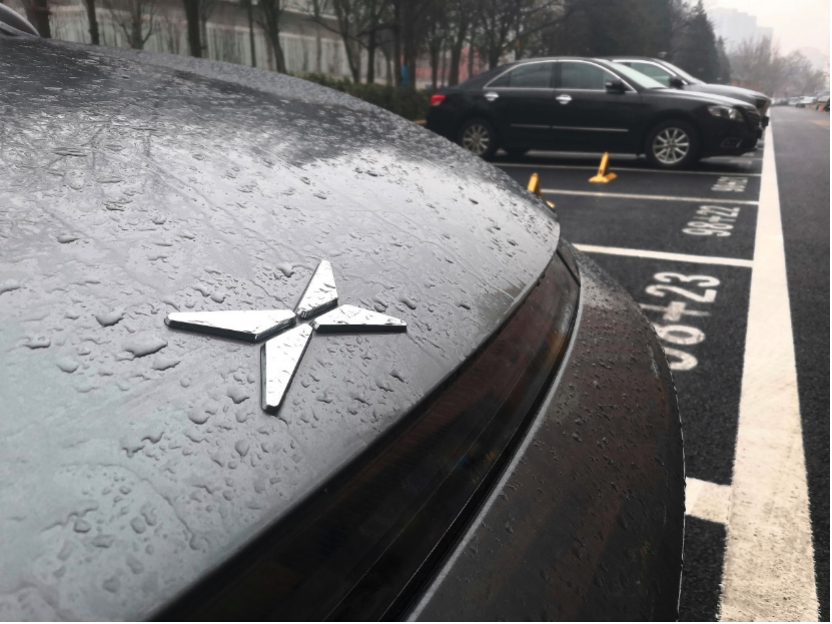
My trip includes high-speed driving, and the air conditioning is on normally. I don’t really care about electricity consumption, after all, the cost of electricity is much lower than that of a gasoline vehicle. It doesn’t make much sense to calculate the fuel consumption cost like a gasoline vehicle. If combined with the weather and slow charging, it is not difficult for P7 to run an average of 400+ kilometers with a full charge.
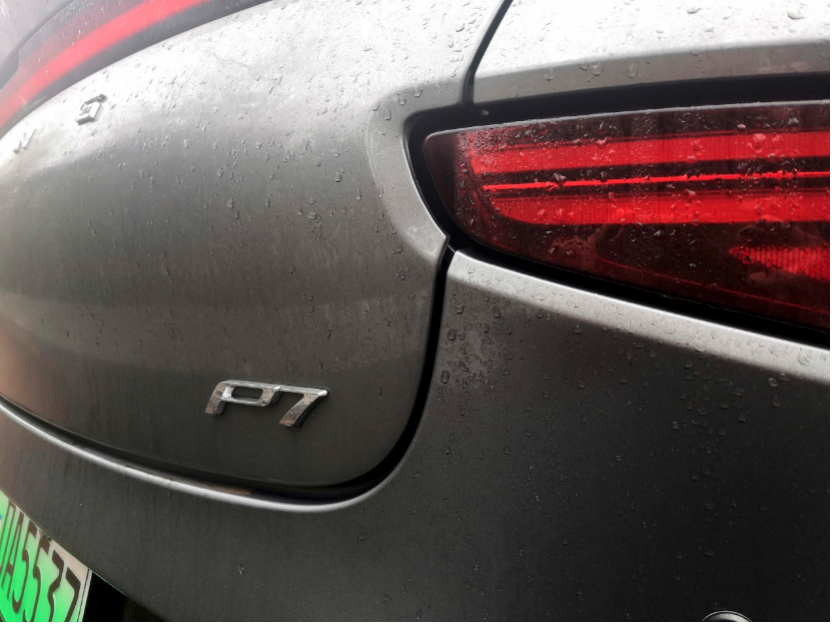
For me, this score is completely acceptable. After all, my actual use of the car is for urban commuting, and it’s enough to charge once a week. P7 can also get 3000 kWh of free electricity per year, which is basically a mileage gift. It can save about 10,000 yuan in fuel costs a year. Of course, it would be better if you have a home charging station, which is more convenient for charging. However, if you have a long distance for daily commuting or need to travel between cities frequently, it is still not enough.
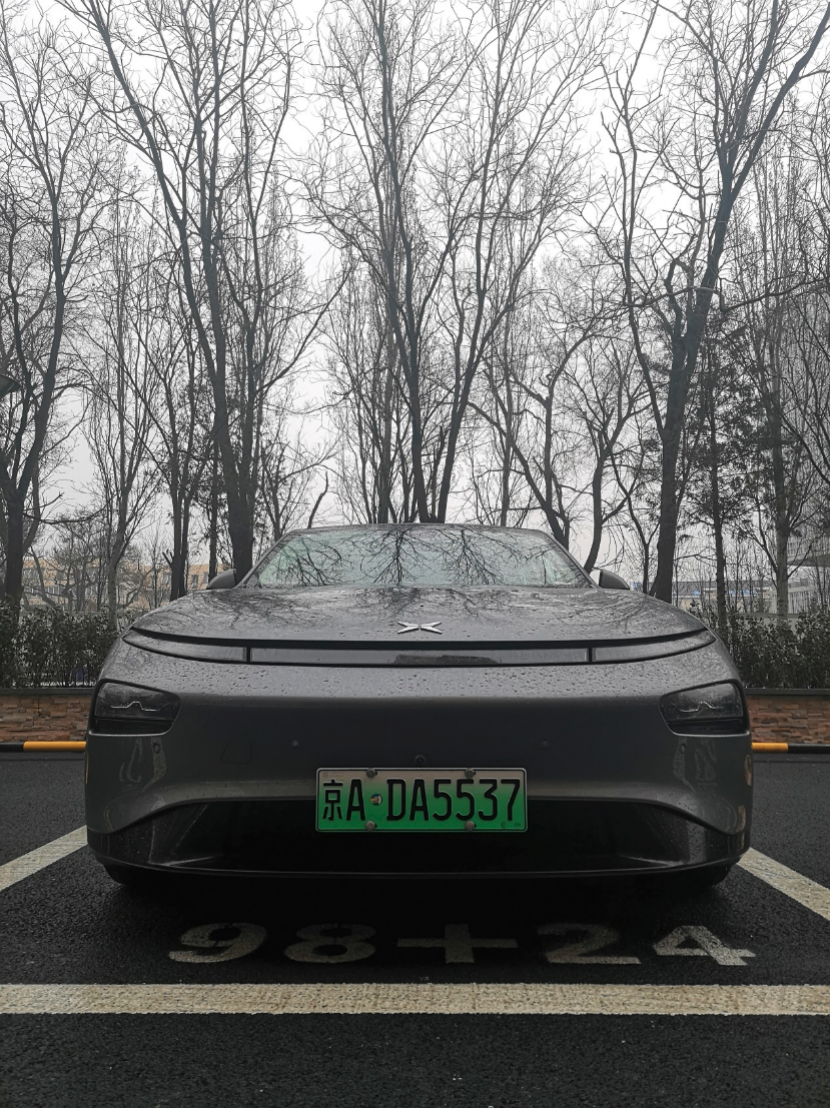
Conclusion
After two days of deep experience, XPeng P7 still surprised me a lot. From the workmanship, materials, driving experience, and intelligent configuration, to the actual endurance and charging convenience, it is definitely worth the price of the 250,000+ yuan level or even higher. If you have a budget of about 300,000 yuan and want to buy a car, especially a new energy vehicle, you can try P7 without worrying too much about the brand. I believe your opinion of this brand will also change.
This article is a translation by ChatGPT of a Chinese report from 42HOW. If you have any questions about it, please email bd@42how.com.
